GUIDE TO ULSTER
ISSUED BY
THE ULSTER TOURIST DEVELOPMENT ASSOCIATION
BELFAST:
Printed by WM. STRAIN & SONS, LTD., GT. VICTORIA ST.
1925.
FOREWORD.
The Ulster Tourist Development Association, presents to the traveller in all parts of the world this brochure in the hope that after perusal of its pages the reader will decide to visit a country of grandeur and beauty which possesses and provides health and pleasure for the seeker of peaceful days, assured of a real Ulster welcome which will impress and remain in the realms of happy memory.
Steeped in legend and tradition ecclesiastically and historically Ulster is, nevertheless, a great commercial province. The scenery of the famous coast roads, the amphitheatre known through the ages as the Giant's Causeway, and many a picture of unsurpassing natural beauty beside which the charms of Switzerland and Italy, the lure of the Riviera, and the beauty of Chamonix, pale into insignificance, combine to make this province the world's premier pleasure and health resort.
Organizing Secretary -- ERNEST PATTON.
Headquarters -- 5 Donegall Square South, Belfast, Ulster.
COUNTY ANTRIM.
THE natural beauties of County Antrim are known the world over. The County forms a somewhat narrow parallelogram, and a striking feature of the landscape is the series of heights of 1,000 feet and more which lie within two or three miles from the sea all the way from Ballycastle to Larne, and which form a picturesque and noble background to the fine scenery of the coast itself.
Many relics of an era long dead when Christianity was young abound, and the contrast from the amphitheatre, where the giant played his majestic organ at the Giant's Causeway, to the reed-fringed and bird-haunted silence of the vast lake Lough Neagh, makes the County an ideal spot for the traveller.
Seaside Towns of Co. Antrim.
Ballintoy. -- A pretty town on the coast situated picturesquely amid surrounding hills, about seven miles from Ballycastle. The district possesses many attractions for antiquarians. The far-famed Carrick-a-Rede Swinging Bridge is only a mile distant.
Ballycarry. -- The village stands at the head of Larne Lough, and contains the ruins of the first Presbyterian Church erected in Ireland. The road connects the mainland with Islandmagee -- a famous tourist resort.
The Gobbins. -- The bold cliffs known as The Gobbins lie off the eastern shore of Islandmagee, about three miles from Ballycarry Station. They can be conveniently reached from the station by the public road which leads to the top of the Gobbins Brae, or by the Gobbins Path, which commences about a mile from the station.
The Gobbins consist of great precipices of basaltic rocks extending along the shore for about a mile and a quarter, and rising sheer from the sea to a height of 240 feet. The rocks are the home of great flocks of sea-birds, and are penetrated by numerous caves, one of which has yielded a fragment of an antler of the red deer and a miscellaneous collection of bones. The Gobbins, according to one tradition, were the scene of a dreadful massacre, about the year 1641, when many of the natives were hurled over them into the sea. Another tradition, however, says that only one woman met her death in this dreadful way. (See O'Laverty's "Diocese of Down and Connor.") Up till the year 1902 an adequate view of The Gobbins could only be obtained from the sea, but in that year a cliff path, constructed by the Engineer of the Belfast & Northern Counties Railway, rendered them accessible to pedestrians. The pathway runs near the base of the cliff, and, in some places, is cut out of the almost perpendicular face of the rocks. The Man-o'-War Sea Stack, a conical-shaped rock, surrounded by water, has been connected with the mainland cliff path on one side by a remarkable open-work tubular bridge, oval in section, and constructed of steel; and on the other side by a shorter ordinary steel girder bridge. The view from these bridges is very striking.
Ballycastle. -- Is delightfully situated by the sea at the foot of one of the nine Glens of Antrim. It has an extensive strand, and bathing places, golf links, and a specially fine series of tennis courts.
Behind the town towers the great mass of Knocklayd, a rounded hill, 1,695 feet in height. In front is a beautiful bay curving away on the right to the majestic promontory of Fair Head. Across the bay, about four miles distant, is the cliff-walled island of Rathlin, to which Robert Bruce fled from Scotland in 1306. Here he is said to have watched a persevering spider, and to have learnt therefrom the lesson which resulted in "Bannockburn."
Ballycastle is about five miles from the celebrated Carrick-a-Rede swing bridge formed of planks laid two abreast and lashed to ropes, a single rope serving as a hand-rail. The bridge is put up solely for the fishermen passing between the mainland and the rock during the salmon season. Carrick-a-Rede signifies the "Rock-in-the-Road," and is so called because it intercepts salmon moving round the coast.
Ballycastle is a convenient centre for visiting a number of interesting places and some of the grandest scenery on the Antrim Coast. (See the section on Antiquities). Among them are -- GREY MAN'S PATH, MURLOUGH BAY, CARRICK-A-REDE, KINBANE CASTLE, DUNINENY CASTLE, RATHLIN ISLAND, BONAMARGY ABBEY (ruins), ARMOY (Church and fragment of a Round Tower, about six miles (by rail) from Ballycastle. Further information as to Hotels, Boarding Houses, etc., may be obtained on application to the Town Clerk, Ballycastle, Co. Antrim.
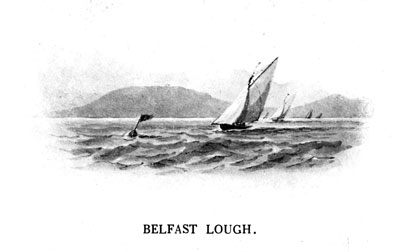
Belfast -- Was constituted a Corporation by Charter of King James I. in 1613. The City, which had a population of only 53,287 in 1831, had grown to 386,947 in 1911, and the present estimate is 458,000. The valuation in 1841 was £135,000, to-day it is £1,817,727. Its fine streets, public buildings, and squares make Belfast quite worthy of its position as the finest commercial City in Ireland, an the capital of a newly-created state.
No port in the United Kingdom can compare with Belfast for excellent cross-channel services. These are in alphabetical order.
From Ardrossan.
From Fleetwood.
From Glasgow.
From Heysham.
From Liverpool.
From Stranraer to Larne, thence by short train route.
The construction of Belfast Harbour was a triumph over great natural difficulties, and to-day when the yards of Messrs. Harland & Wolff and Messrs. Workman & Clark can boast that they were "the birthplace of the modern leviathan," one is apt to forget that Belfast is built on mud.
The Museum Building, the Patterson Public Museum, Municipal College of Technology, the Assembly Buildings, the Ulster Hall, St. Anne's Cathedral, the Custom House and Albert Memorial, the Queen's University, the Royal Victoria Hospital, and the Mater Infirmorum Hospital are only a few of the splendid buildings which are worth a visit. The City Hall, erected at a cost of half-a-million sterling, is of Portland stone, and contains inside stately halls of Greek and Italian marbles, and suites of rooms approached by marble staircases. This Hall boasts of many attractive memorial windows, but the one of which Belfast is most justly proud is that which commemorates the deeds of her sons on the battlefield in the great war, and which bears a tablet containing the tribute of King George V. -- "Throughout the long years of struggle, which have now so gloriously ended, the men of Ulster have proved how nobly they fight and die." A Museum, the foundation stone of which was laid by H.R.H. The Duke of York on 22nd July, 1924, is at present being erected in the Botanic Gardens. The first section of this Museum will cost over £80,000.
In the matter of Public Parks Belfast caters well for the citizens. From the beautiful grounds at Bellevue Gardens a splendid view of the Lough can be obtained; the Botanic Gardens with its unique fernery and spacious conservatories; the Ormeau Park, of 100 acres, with its facilities for cricket, croquet, tennis, golf, boating, football, and other pastimes; the Alexandra Park, with its well-arranged flower beds, and several other minor Parks all attract the visitor by their beautiful scenery.
Linen is the premier industry, and has made the name "Belfast Linen" a household word over the whole world; but next only in importance is the Shipbuilding industry, for Belfast was the birthplace of the Britannic, the ill-fated Titanic, and the Olympic.
Five of the largest concerns in the world are domiciled here and are well worthy of a visit.
Carrickfergus. -- The ancient town of Carrickfergus has a great deal to interest and attract the tourist. As a holiday resort it is quiet and restful, with excellent bathing and boating facilities. It is on!y a few minutes rail journey from the golf courses of Greenisland and Whitehead; the main road passing through it from Belfast merges a few miles farther on into the world-famous County Antrim coast road, with its unrivalled panorama of magnificent scenery; the City of Belfast, and the popular resorts of Whitehead, Islandmagee (for the Gobbins cliffs), and Larne, are all only a few minutes journey by rail; while Portrush and the Giant's Causeway, Ballycastle, and other well-known places of interest are within easy reach. There are several tennis clubs in the town, to which visitors can gain easy admittance, and many other forms of summer amusements are in vogue during the season. In the winter the town is equally well served, several association football clubs, a rugby club, and ladies' hockey clubs, cater for those who are inclined to sport.
The town is noted for its salt mines (four in number) worked under the control of the Salt Union, Ltd.
The most interesting feature of the town is the fine old Castle, erected in the 12th century by John de Curci, who captured the town in the year 1176. This old fortress still stands as it stood centuries ago guarding the town which was in the earliest days of Irish history the principal stronghold in the North of Ireland, and passed through many vicissitudes and changes. Since that time the Castle has been subject to many changes and modifications by its numerous occupiers, and it is one of the few existing edifices in the Kingdom which exhibit a specimen of the old Norman military stronghold. It is interesting to note that the Castle is still in military occupation, being used in connection with the Army Ordnance Department.
There are several other objects and places of historic interest, which are detailed in the section on Antiquities.
Further information as to Hotels, Boarding Houses, etc., may be obtained on application to the Town Clerk, Carrickfergus, Co. Antrim.
Carnlough -- Is a very pretty little watering-place a few miles from Larne, with a fine sandy bay -- good bathing. Limestone is shipped from the small harbour, which was finished in the year 1854. This resort is ideal for those who desire a holiday in a quiet yet attractive locality.
Cushendall -- Affords good bathing at Limerick Point and Salmon Rock. Cushendall may be made the centre for visiting Glenan, Glendun, and Glenariff. The last-mentioned is the most beautiful of the Antrim Glens. (See the section on Antiquities).
There is good trout fishing in Glenariff, Glendun and Cushendall Rivers (free).
Cushendun -- A small village four miles distant from Cushendall is an ideal spot for a quiet holiday. There is a good Hotel (run on up-to-date lines), and first-class deep sea and stream fishing. Cushendun was the birthplace, and is the home of Moira O'Neill, the famous poet.
The Giant's Causeway -- So artificial looking, and yet so far beyond the power of human skill, has been a place of interest to the curious traveller for over 300 years. Its remarkable columnar formation has been discussed by the learned for ages, and still presents many problems for final solution. About 4,000 basaltic columns, packed closely together, form this unique mole or causeway projecting into the sea. In form the columns are irregular polygons, from three to nine sides, broken into varying lengths by concave-convex fractures.
Numerous caves, bays and headlands adjoining the Causeway present many features of great scenic grandeur.
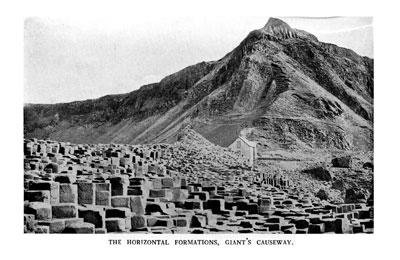
Passing through the entrance gate, a little to the left is the Giant's Well, where the curious will note the impress of the Giant's knee in one of the stones, made as he stooped to quench his thirst, while at the bottom of the well itself may be seen the shape of the shamrock. From this point, the Stookans, is a rock, not unlike an old woman with a cloak thrown over her bent shoulders, known as the Giant's Cranny. On the face of the cliffs above will be observed the ends of some horizontal columns called the Giant's Cannon. A group of columns of the Honeycomb forms a comfortable seat known as the Wishing Chair. Anyone sitting in it and wishing three wishes will, it is said, find them all coming true inside twelve months. On the west side of the Grand Causeway is Lord Antrim's Parlour, where, at one time, the Guide says, "Lord Antrim of Ireland gave a great feast." On the Grand Causeway can be seen the Ladies' Patchwork, the Giant's Horseshoe, the Diamond-shaped Column, the Lady's Fan -- an arrangement of the stones harmonising well with the name, the Keystone, which has eight sides, a stone with nine sides, and the Giant's Coffin. Turning towards the cliffs is Portnoffer and past the Giant's Loom, a series of columns which are, on the average, 30 feet high. Between the Loom and a cluster of columns leaning against the headland is the opening known as the Giant's Gateway. About midway along Portnoffer, a footpath known as the Shepherd's Path leads to the head of the cliffs, and presents a bit of stiff climbing.
Round Portnoffer we pass a group of massive basaltic columns on the face of the cliffs known as the Giant's Organ, which "plays once in seven years, and then only two tunes." From Portnoffer one enters the Giant's Amphitheatre, which is considered by many to be the finest of the bays. "Round the upper part runs a row of columns eighty feet high; then comes a broad rounded projection like an immense bench for the accommodation of the giant guests of Fin MacCoul ; then again a row of pillars, 60 feet high, and then again a gigantic bench, and so down to the bottom, where the water is enclosed by a circle of black boulder stones like the limits of the arena." (Kohl.) The cliffs around this bay rise to a height of 350 feet. Next is Port-na-Spania, on the western side of which the isolated columns called the Chimney Tops or (Chimney Pots) stand about 300 feet above sea level. Tradition says that one of the ships of the Spanish Armada fired on them during the night in mistake for the chimneys of Dunluce Castle.
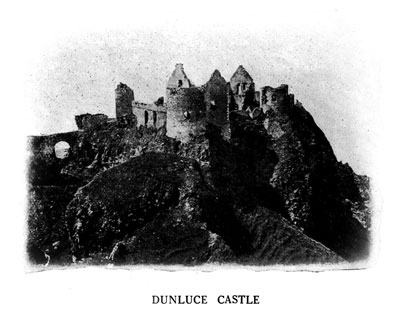
The cliff-path proper terminates in the next bay, Port-na-Callian, where it commands a splendid view, including the rock known as the Giant's Eye-glass, and The King and His Nobles, and the superb headland of Pleaskin.
An Electric Tramway, the first undertaking of its kind in Great Britain, runs from the Causeway to Portrush. The Tramway skirts the top of the headlands for part of the journey, and affords fine views of the bold scenery of the coast. En route are the extensive ruins of Dunluce Castle, standing on a rock separated by a slight chasm from the mainland; and further on is the town of Bushmills, in which the whiskey known as "Old Bushmills" is produced.
Glenariff Glen -- The most beautiful of the Antrim Glens -- is within easy reach of the village of Cushendall.
It can also be reached by direct rail from Belfast. In the latter case passengers change at Ballymena to the narrow-gauge train for Parkmore. Parkmore Station stands at an elevation of 850 feet above sea level and commands a fine view of the Vale of Glenariff.
A delightful mixture of waterfall, rock and tree, combines to make the Glen the most enchanting sylvan glade in Ireland. Bracket paths and rustic bridges render the Glen easily accessible. Ess-na-Larach -- "the fall of the battlefield," Ess-na-Crub -- "the fall of the hoof," and "The Tears of the Mountain," are the finest of the numerous cascades and waterfalls which follow a delightfully picturesque course over varicoloured rocks. At the foot of the Glen is a tea-house, from the verandah of which is a charming view of woodland and mountain scenery.
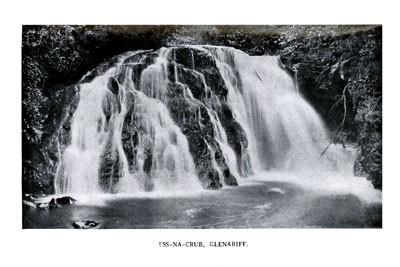
Garron Point. -- The imposing headland at Garron Point is formed of the limestone and basaltic rocks which have slipped from the hills behind.
Garron Tower -- A castellated mansion, now used as a first-class Hotel, stands on the basaltic plateau formed by the slip. There is a magnificent prospect from the grounds of the tower which was erected in 1848, during the famine, by the then Marchioness of Londonderry as a dower house, and contained a marvellous collection of curios, works of art, coats of arms, and fine carving.
Further information may be obtained on application to the Manager, Garron Tower, Larne, Co. Antrim.
Glenarm -- A small town about 12 miles from Larne, standing at the mouth of a beautiful valley. Glenarm Castle, which stands at the bottom of one of the streets, is now occupied by the Earl of Antrim. Over the gateway there is an inscription which reads -- "With the leave of God this Castle was built by Sir Randle McDonel, Knight, Erle of Antrim, having to his wife Dame Aellis O'Nill, in the year of our Lord God, 1636, Deus est adjutor meus." The Castle occupies a commanding position, and has a fine deer park, a pretty waterfall, salmon leap and charming walks. The remains of a Franciscan Monastery, founded in the fifteenth century, are to be seen in the Churchyard on the north side of the town.
Glynn -- A pleasant hamlet at the mouth of the little Glynn river or water. About 3 minutes' walk from the Station are the ruins of an ancient Church, situated on the bank near the river, which here runs through a shady glen. The nave and chancel are in different styles of architecture; in the former the windows are square, surmounted by a flat slab instead of an arch, while the east of the chancel is pointed.
Islandmagee -- The peninsula called Islandmagee commences near Whitehead Station, and contains about 7,000 statute acres of well-cultivated land. It is separated from the mainland by Larne Lough, and is named after a family of the Magees, who settled here before the seventeenth century.
The northern portion of the "Island" is a few minutes by ferryboat from Larne. At the Druid's Cottage, which is about half-a-mile from the ferry, there stands a group of massive stones, known as the Druid's Altar. Cold ornaments are said to have been found in the neighbourhood of this cromlech.
On the shore near Brown's Bay stands a "rocking stone," one of the many evidences found in this district of what geologists term the "glacial epoch." It is an ice-borne block, and is said to weigh from 10 to 12 tons.
Larne -- An excellent tourist centre with abundant hotel and lodging-house accommodation, is connected with Great Britain by a Royal Mail Service from Stranraer, known as the "Short Sea Route."
There are two stations in the town -- one on the broad-gauge line, which runs to Belfast; the other on the narrow-gauge line, which runs to Ballymena. Both lines terminate at Larne Harbour, which is alongside the berth of the Larne and Stranraer Royal Mail Steamers. The establishment of this route between Great Britain and Ireland has already raised Larne to a position of the greatest importance. The harbour is sheltered and commodious, and its depth even at low water is sufficient to float the largest transatlantic vessels. The salubrious situation, and the great facilities offered by the Railway Company, have largely increased the popularity of Larne as a summer resort and watering place. Numerous villas and handsome residences have of late years been erected about the town and along the seashore. There are large numbers of boarding houses, ample hotel accommodation, and safe and excellent sea-bathing. The neighbourhood furnishes many picturesque and interesting localities, while for a walking, cycling, or car tour, few roads surpass that which for 25 miles skirts the coast from Larne to Cushendall. The botanist will find many a "happy hunting-ground" in the surrounding districts, while the geologist will be able to pursue his favourite pastime or study among the fine sections exposed on the shore near the harbour, and along the bold headlands of the coast.
Glenoe Waterfall can be reached from Larne in about an hour and a quarter. The walk may be made along the top of the Bank Braes, which are reached by passing through Inver village.
At the top of the village lies Casement's Brae, a very steep road on the extreme left, and in a few minutes the tourist comes to a point from which there is a splendid panoramic view, embracing the Mull of Cantyre, Ailsa Craig, The Maidens, Islandmagee, Chaine Memorial Tower, Larne Harbour and Town.
In about an hour from Larne some cottages appear known as the Cruckit Raw (Crooked Row), and straight on lies the sequestered village of Glenoe. The waterfall consists of four cascades, known respectively as the Upper Fall, the Middle Fall, the Kist (chest), a cleft in the rocks, and the Plumb, or Lower Fall. A broad pool lies at the bottom of the Plumb, which is the principal cascade. The ravine down which the waters tumble is beautifully wooded with beech, elm, larch, and sycamore trees; delicate ferns flourish in the shade; a soft green moss carpets the humid stones, and ivy clings to the weathered rocks that crop out along the precipitous slopes. Above the edge of the Falls stand the little village Church and the graveyard where "heaves the turf in many a mouldering heap." In the adjacent quarries the geologist will find a good section of the chalk formation, in which he will notice the flint nodules lying about the planes of bedding.
Golf links, with a nine-hole course, on Islandmagee. Further information as to Hotels, Boarding Houses, etc., may be obtained on application to the Town Clerk, Larne, Co. Antrim.
Magheramorne. -- Extensive land quarries and lime works are seen near the station. The works of the British Portland Cement Company are situated on both sides of the railway. From the small port large quantities of the lime are shipped in small vessels to other ports in Ireland and in Scotland. A ferry boat plies between this station and Millbay, in Islandmagee. (Distance -- about a mile).
Portballintrae. -- A beautiful seaside village between Portrush and the Giant's Causeway. As a quiet pleasure resort it is an ideal spot for tourists.
Portrush. -- The hand of the Master Painter must have lingered long to produce such a picture of surpassing beauty as this town on the bold headline of the Antrim Coast, from which can be seen miles of entrancing scenery.
Portrush, standing on a peninsula ending in the fine cliff wall promontory, Ramore Head, is the only seaside resort in Great Britain surrounded on three sides by water. There is not a factory chimney to be seen within the wide horizon, and the Urban Authority is alive to the fact that "cleanliness is next to Godliness."
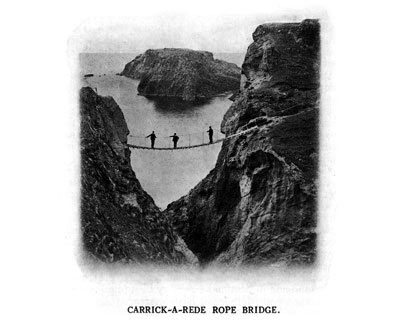
For bathing facilities its position is unique -- one may bathe either at the South Pier, or the adjacent beach, or the Blue Pool (a natural amphitheatre), or the ladies' bathing place. Ramore Head is Portrush's playground with two first-class bowling greens and ten tennis courts of grassy turf and four hard courts. There are excellent Cricket, Hockey and Football Clubs, and the Committees of these are always eager to arrange fixtures with visitors' teams. Boating, fishing, motoring, and cycling can all be indulged to the full, while in most of the restaurants and hotels evening dances, complete with orchestra, are frequent. There is an abundance of good hotels and boarding houses.
To mention Portrush is to suggest golf. Its links are famous -- indeed many experts say they are the best in the world. There are two eighteen-hole golf courses, frequently the venue of the Irish Championship, and truly indeed did the London "Times" say -- "It is a jolly place with very jolly golf, and it has that indefinable innate quality of rearing golf champions."
With Portrush as a jumping-off ground many and varied excursions can be made -- to the Giant's Causeway by tramway (the first Electric Tram in the United Kingdom), which runs past the White Rocks, the Giant's Head and hoary Dunluce Castle; to Portstewart, three miles away with its old-world Castle; to the famous golf links at Castlerock; to Coleraine and the fascinating Salmon Leap on the River Bann; to the Skerries, an ideal spot for picnics; to Bushmills, the seat of the whiskey trade; to the swinging bridge of Carrick-a-Rede; to the Glens of Antrim, Derry, Moville and Rathlin. Truly Portrush combines with great natural beauty the pleasures of Blackpool, Brighton and the Isle of Man.
Before you die you must see the Giant's Causeway, so accessible from Portrush - the Causeway like nothing else in the world -- a natural amphitheatre -- frescoed and emblazoned by the hand of God. .
Further information as to Hotels, Boarding Houses, etc., may be obtained on application to the Town Clerk, Portrush, Co. Antrim.
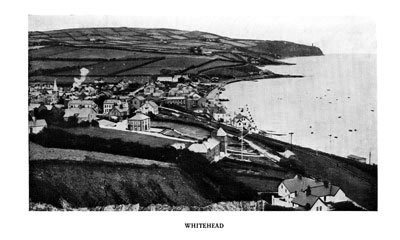
Whitehead -- At the mouth of Belfast Lough -- is one of the most popular seaside resorts near Belfast.
The fine esplanade was constructed by the Railway Company, and during the season various entertainments are provided at the bandstand. There are good facilities for golf, bathing, and boating. There is a local Yacht Club.
A short distance from the town are the Caves and Cliffs of Blackhead, the exploration of which has been made quite easy by paths, footbridges and handrails.
Inland Towns of Co. Antrim.
Ahoghill. -- A small village, four miles from Ballymena, and served by motor omnibus from that town.
Antrim. -- A market town, 17 miles from Belfast, on L. M. & S. line. The famous Lough Neagh, the largest lake in the United Kingdom, is within half a mile of the town.
Just after leaving the station, one of the ancient Round Towers of Ireland may be seen on the right.
Armoy. -- Six miles from Ballycastle on the Ballycastle Railway, Armoy is beautifully situated on the River Bush, a good fishing river for both trout and salmon. About half a mile distant stands one of the old Round Towers.
Ballyclare. -- A flourishing market town, ten miles from Belfast. A bauxite mine in the vicinity has a large yield.
Ballymena. -- (33t miles from Belfast). The Ballymena and Park more (for Glenariff and Cushendall) and the Ballymena and Larne narrow-gauge branches start from this station.
Ballymena is a thriving business town on the Braidwater River. It is largely engaged in the manufacture of linen, in flax spinning, in the production of damasks, cambric handkerchiefs, and embroidered goods, and in the curing of ham and bacon; it also carries on an extensive trade with England and Scotland.
Further information as to Hotels, Boarding Houses, etc., may be obtained on application to the Town Clerk, Ballymena, Co. Antrim.
Ballymoney. -- (53¼ miles from Belfast). Population 3,100. Ballymoney is an agricultural market town. A narrow-gauge railway runs from Ballymoney to Ballycastle, on the North Antrim Coast.
Broughshane. -- A village 3½ miles from Ballymena, the ancestral home of Sir George White, V.C., the famous defender of Ladysmith.
Bushmills. -- A neat little town on the River Bush. The river is well supplied with salmon and trout, and affords good sport to anglers. The town has acquired a more than local reputation by its production of whiskey known to connoisseurs as "Old Bushmills."
In the midst of an extensive plantation lies Dundarave House, the seat of Sir Francis MacNaghten, Bart.
Cullybackey. -- A village beautifully situated on the River Maine. There are extensive Bleach Works.
Dunadry. -- Donegore Hill and Moat were the insurgents' rendezvous in the rebellion of 1798. Rathmore is an ancient fort supposed to date from the second century. The district has well stocked trout streams.
Glenavy. -- A charming village 1½ miles from Lough Neagh and 14 from Belfast. The Glenavy river is a favourite resort for anglers, and the district is rich in historical places of interest.
Lisburn. -- A prosperous town on the River Lagan, seven miles south of Belfast. Flax-spinning, manufacture of linen and thread, bleaching and damask weaving are all carried on extensively. Architecturally the chief feature is the Cathedral, built in 1622 with fine octangular spire and numerous monuments, including one of Bishop Jeremy Taylor, who was at the Restoration created Bishop of Down and Connor.
Muckamore. -- A thriving village twenty miles by L.M.S. Railway from Belfast. It is noted for extensive Bleach Works and the beautiful scenery in the surrounding country.
Portglenone. -- A small town on the River Bann, noted for its manufacture of bricks from the peculiar white clay found on the banks of that river.
Randalstown. -- An industrious town on the River Maine close to a magnificent park, owned by Lord O'Neill, open to the public.
^ top of page
COUNTY ARMAGH.
Armagh the County and Armagh the City unite, with their memories of St. Patrick, St. Brigid, and St. Columba, in making a region rich in Irish history and legend.
Two miles to the north of the City of Armagh is the site of the "Battle of the Yellow Ford," in which Hugh O'Neill, a member of the rebel army that troubled Armagh in the 16th and 17th centuries defeated an English force.
To the archaeologist the most interesting feature may be Navan Fort, founded by Queen Macha, and the site of the Royal Palace where the old time Kings of Ulster ruled for a period of 600 years. The site is an ellipse and in places the great entrenchments still remain perfect.
Historically, archaeologically, and for its scenic beauty, the County of Armagh must make a great appeal to the traveller.
Armagh. -- The town, situated on the sloping sides of gently ascending hills, is probably the most beautiful inland town in Ireland. Venerable for its antiquity the city owes its origin to St. Patrick the Apostle of Ireland; it was once the capital of Ireland. "Navan Fort," about 1½ miles from the city, which dates back as far as 300 B.C., was the residence of the Kings of Ulster for centuries. Brian Boru, the only King of Ireland, killed at Clontarf, lies buried here in St. Patrick's Cathedral; King Niall III., of the Nine Hostages, is interred close by.
The Public Library, endowed by Primate Robinson, otherwise Lord Rokeby, contains copies of ancient and modern literature numbering over 20,000 volumes. The Royal School, founded by Charles I. in 1627, has always been and is still one of the chief seats of learning in Ireland.
There are four junction railway lines.
Armagh has an Observatory which has become famous.
It possesses two Cathedrals and two Palaces. Both Cathedrals are called after St. Patrick -- one is built of red sandstone, the other of limestone. The Roman Catholic one is of unsurpassed magnificence, both internally and externally.
The visitor in Armagh will be struck with the large amount of red marble, which is quarried locally, in the buildings and pavements.
There is an excellent nine-hole golf links in the picturesque Palace demesne, open all the year round.
Roxborough Castle, one of the landmarks of Armagh, is a modern building of stately design.
Further information as to Hotels, Boarding Houses, etc., may be obtained from the Town Clerk, Armagh, Ulster.
Bessbrook. -- A small town situated in a beautiful and well-watered valley convenient to the Camlough mountains. There is an electric tramway from Newry, three miles distant. The scenery is very beautiful. The towelling, diapers, damasks, etc., made at Bessbrook, are known the wide world over. The town is without public-house or pawnshop.
Crossmaglen. -- A town 1½ miles from Culloville on the C.N.R. The district is rich in minerals, silver, lead and tin.
Lurgan. -- An important Railway junction -- a linen and cambric manufacturing town. There are twenty-two large factories. The township is annually increasing and contains a beautiful park, at one time the home of Lord Lurgan.
Markethill. -- A small town 8¾ miles from Armagh. The Earl of Gosford is the owner of Markethill and vicinity, and his Castle stands in a well-cultivated demesne of 645 acres. The Castle is built with granite in the Norman style. There are several Danish forts within the demesne, which was the favourite resort of Dean Swift.
Poyntzpass. -- Eight miles from Newry, is a town on the Great Northern Railway. A short distance away are portions of remarkable earthworks, and the Great Wall of Ulidia or Ulster; the wall can be traced from Lisnagade, north of Scarva, to near Jonesborough, and is a most remarkable erection.
Portadown -- Twenty-five miles from Belfast. One of the most prosperous and best market towns in Ulster -- is noted for its monthly and bi-monthly cattle fairs.
It is the Railway Junction connecting with Dublin, Enniskillen, Londonderry, and Belfast, and is the market town for the garden of Ireland situated between Portadown and Loughgall, where thousands of acres of apples and strawberries are grown annually. In the month of June when the trees are in bloom it is a beautiful sight. There are two large Nurseries close to the town, one covering about 100 acres, where most of the famous roses in the Kingdom have been raised.
It offers to the tourist a fine fleet of motor cars and char-a-bancs, capable of communicating with all places of interest.
Portadown possesses eight or ten weaving factories and a spinning mill, and the proprietors of these will be pleased to show visitors over their works, thus affording an opportunity of seeing the manufacture of some of the finest textile work the world can produce.
The population is about 14,000, and there are two up-to-date hotels and several restaurants, which cater well for visitors.
The Newry Canal, which joins the River Bann, about one mile from the town, places Portadown in direct communication with Newry and Belfast. Barges of 60 to 80 tons burden carry coal, grain, timber and other merchandise to the town at very reasonable rates.
Further information as to Hotels, Boarding Houses, etc., may be obtained on application to the Town Clerk, Portadown. Co. Armagh.
Richhill. -- A small town five miles from Armagh, in the heart of a prosperous fruit-growing district. Furniture is manufactured in the district. An obelisk in the grounds of Castle Dillon commemorates the formation of the Irish Volunteer Force in 1782.
Tandragee. -- A market town twenty-four miles from Belfast, on the estate of the Duke of Manchester. The C.N.R. and the Newry Canal afford the town all facilities for trading.
Tynan. -- A picturesque village, rich in historical associations.
^ top of page
COUNTY DOWN.
When all is so beautiful in this County it would be invidious to mention any particular place, so the tourist will have to try to decide for himself which place shall become his headquarters.
Steeped in ancient legends and studded with ancient monuments, County Down to-day caters extensively for the visitor, and has many and varied beauty spots to show, while in sport of all kinds facilities are available such as cannot be found in any other corner of the world.
Seaside Towns of Co. Down.
Annalong. -- A post town on the road from Kilkeel to Newcastle has a commodious harbour, where a great fishing industry is carried on, and a very extensive trade done in shipping granite from the Mourne Mountains to all parts of the United Kingdom.
Ardglass. -- Situated on a high promontory on the coast, Ardglass was at one time a place of importance, and retains as monuments of its ancient grandeur five old castles. It has the most important herring fishery in Ireland -- over 200 boats being engaged at the summer fishing. The town is much patronised as a holiday resort.
Ballywalter -- Is a clean and thriving village thirteen miles from Bangor. Adjoining the town is Ballywalter Park, the seat of Lord Dunleath, and close by are the ruins of two old abbeys. It is remarkable for its beautiful situation and for the salubrity of the air. Ballywalter boasts no doctor or policeman.
Bangor. -- About twelve miles from Belfast is situated on a beautiful bay at the entrance to Belfast Lough, and is justly famed as being one of the most beautiful health resorts in the Kingdom. The scenery around Bangor is entrancing, and the irregularity of the shore line produces a most pleasing diversity of scenic effects. The history of Bangor is contemporary with that of Christianity in Ireland. In the early days it was a great seat of learning, and from its famous monastery missionaries carried the gospel to distant parts of Europe. Nature, aided by modern day Arts, has to-day made Bangor one of the most beautiful and healthy towns in Ireland.
At the foot of the main street lies the Esplanade, where open-air entertainments are held regularly; and close by are the Marine Gardens, extending over a mile on the sea front and forming the chief promenade.
Bangor boasts many beauty spots, but perhaps the most beautiful is Ward Park, which is about thirty-seven acres in extent, and is divided into two unequal parts by a stream crossed by several bridges and artificially expanded in two places, forming pretty ponds. In the Park are seven grass and two hard tennis courts and a bowling green, to all of which visitors can obtain admission. There are three recognised bathing-places in Bangor -- (1) The Pickie Rock for mixed bathing; (2) The Skipping Stone Bathing Place for ladies; and (3) The Ballyholme Bathing Place for mixed bathing; but beach bathing may be availed of to the fullest extent, free of charge, on the sandy shores of Ballyholme Bay which extend for about a mile.
Bangor is the principal yachting centre of the North of Ireland, and is the headquarters of the Royal Ulster Yacht Club, whose Club House is the finest of its kind in the Kingdom, except that of Cowes. The Club holds a two-day annual regatta in June, which attracts all the crack boats in British waters. The Ballyholme Club also has a large membership, and the Club's Annual Regatta is one of the most popular of the season.
Bangor possesses an excellent 18-hole golf course, scientifically bunkered. Variety is a great feature, for every club has to be brought into action, and the player who equals bogey (76) must display skill, versatility and resource. A visitor can at almost any time of the day find a partner without difficulty, as there are a large number of temporary members.
To sum up, the visitor here can fish either close to the shore or in the deep sea, can play golf, tennis, or bowls, can see up-to-date pictures in a well-equipped picture house, can bathe and listen to open-air concerts, or can dance to the strains of a pleasing orchestra in one of the many "winter gardens."
Further information as to Hotels, Boarding Houses, etc., may be obtained on application to the Town Clerk, Bangor, Co. Down.
Crawfordsburn -- Is a charmingly situated village, two miles from Bangor, with a beautiful Glen.
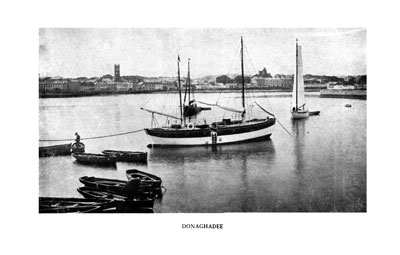
Donaghadee -- 6½ miles from Bangor. Donaghadee is situated on the Irish Sea, and is the nearest point in Ireland to Portpatrick in Scotland, which can be seen distinctly on a clear day; until recent years a postal service was carried on between these two ports.
Popular tradition says that St. Patrick once landed near here, and the mark of his foot is still pointed out on the rocks at Templepatrick hard by, while a well of limpid water, known as St. Patrick's Well, is supposed to cure headaches. There is a beautiful and most substantial harbour and lighthouse built by Government for the accommodation of steampackets. Donaghadee possesses all the advantages of a first-class bathing resort, good boarding-houses and hotels for the convenience and comfort of visitors, while an 18-hole golf course and tennis courts are part of the town's property. There are many beautiful walks around Donaghadee, and the summer population, which is large and increasing, regard it as one of the most picturesque resorts in Northern Ireland.
Further information as to Hotels, Boarding Houses, etc., may be obtained on application to the Town Clerk, Donaghadee, Co. Down.
Dundrum -- Is a fishing village on a rock-strewn bay three miles from Newcastle. A coal, cargo, and passenger steamer plies twice a week from here to English and Scottish ports, and an extensive import trade exists. Ballykinlar Camp, a training ground for H.M. Army, is two miles away. (See the section on Antiquities).
Greyabbey -- Consists of one long street running inland from the shores of Strangford Lough. The beautiful ruins of the Abbey which gives its name to the town stand at the head of the street.
Groomsport -- A small village, two miles from Bangor, with a picturesque harbour filled with brown-sailed trawlers and fishing boats. Groomsport is an ideal place for a quiet holiday. It is celebrated in Irish history as the spot where the advance party of 10,000 men under the Duke of Schomberg landed from 70 transports in 1689.
The Copeland Islands lie about three miles away, and are visited frequently by picnic parties.
Helen's Bay. -- This is a beautiful spot three miles from Bangor, with many attractions and perfect scenery. The railway station is a picturesque structure built in the old baronial style. The shore of Belfast Lough is only a few minutes from the railway.
Holywood. -- A beautifully-situated town, on the shore of Belfast Lough, is backed by an extensive and picturesque range of hills. The town has been a place of note from the seventeenth century, and is to-day one of the chief military stations. Holywood contains a Maypole, probably the last of its kind in Ireland.
Kilkeel. -- A flourishing town in the barony of Mourne half a mile from the coast. The scenery of the district is remarkably fine, and it is becoming a very popular resort for tourists.
Killough. -- A clean, pretty, quaint village seaport and station on the Belfast & County Down Railway. The main street curves in a semi-circle for a mile round the Harbour, and the street is shaded with a double row of sycamores, about forty years old, which in the summer season make a delightful promenade.
Close by is Castle Park, to which there is free access for all visitors, and which is a pleasing recreation ground.
Killyleagh. -- A seaport situated at the head of a creek on Strangford Lough. There are two extensive spinning mills in the midst of a rich agricultural community, and a large export trade is done in potatoes.
Kirkcubbin -- Is a small seaport on Strangford Lough, mainly used for the importation of coal and the export of grain and potatoes. Newtownards is the nearest railway station.
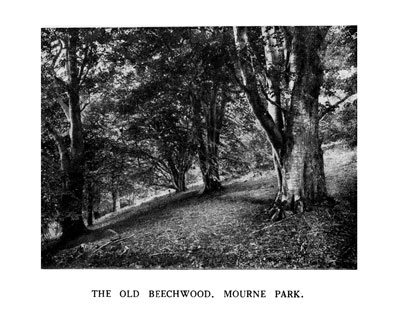
Newcastle -- Is one of the most famous of Irish seaside resorts. Standing out in grand relief and bold outline, overlooking the town, the Mountains of Mourne in their majestic grandeur sweep down to the sea. Along the sloping sides of the mountains the rich and varied tints of fir, oak, larch, holly and hazel trees blend together to form a natural picture exceedingly beautiful. The Donard Demesne is a beautiful park, open to the public.
There are splendid facilities for open sea bathing, and in addition hot, cold, and shower sea-water baths are available at all times.
The Urban Council is very up-to-date, in working for the town's attractiveness -- lawn tennis, croquet and bowling enthusiasts are all catered for, while talented companies of artists give select outdoor performances daily. The town is electrically lighted and the sewerage and sanitation are perfect.
To speak of Newcastle is to speak of the Royal County Down Golf Club, for Newcastle is primarily and essentially a golfer's paradise. These links are renowned the world over, for apart from the scenic beauties, where mountain, valley, sea and stream unite to create a charming picture, the sand dunes along the shores of Dundrum Bar join in making a perfect natural course. Vardon, Ball, Taylor, Herd, White and Sayers, who have often visited Newcastle, declare that the course is one of the best in the Kingdom.
To the angler Newcastle is a select paradise, as here he may fish in half-a-dozen rivers, and permits to do so are easily obtained.
Further information as to Hotels, Boarding Houses, etc., may be obtained on application to the Town Clerk, Newcastle, Co. Down.
Newry. -- A seaport, with a population of 14,000, is very prosperous, thanks to the linen factories and other commercial activities. It is situated on the river called Newry Water, which is spanned by four bridges. The situation is decidedly picturesque, and the run from Newry to Warrenpoint is a delightful study for the sketcher or photographer. Ecclesiastically Newry is far famed for its beautiful Roman Catholic Cathedral, 100 years old, and for the ancient and historic Church of St. Patrick, which was erected in 1578. There are many corn and flour mills, four weaving factories and spinning mills, etc. The port admits vessels of 5,000 tons burthen, and barges ply on the Newry Canal to Lough Neagh 32 miles inland.
Further information as to Hotels, Boarding Houses, etc., may be obtained on application to the Town Clerk, Newry, Co. Down.
Newtownards -- Five miles from Bangor, Newtownards is an important, populous, and prosperous town at the head of Strangford Lough, with the mountain Scrabo towering boldly over it. In the graveyard attached to the Church, which was formerly a monastery in 1244, are the tombs of many members of the Londonderry family. Close to Newtownards are the ruins of the Abbey of Movilla, founded in the sixth century by St. Finian, whose death occurred in 572.
Permission to visit the demesnes of the Londonderry family, with all the interesting relics of bygone ages, may be obtained from the Londonderry Estate Agent in Newtownards.
Further information as to Hotels, Boarding Houses, etc., may be obtained on application to the Town Clerk, Newtownards, Co. Down.
Portaferry -- Is a thriving seaport on the eastern shore of the strait to the sea that forms the entrance to Strangford Lough. There is a good quay.
Rostrevor -- This lovely old-world watering-place, 2½ miles from Warrenpoint nestling under the wooden slopes of the Mourne Mountains, is noted not only for its beautiful situation, but for its mild atmosphere, due to the mountainous amphitheatre in which it sits and which protects it from the winds. It can thus be particularly recommended for invalids or those in search of health. Overlooking Rostrevor is Cloughmore, the Big Stone, weighing forty tons, which legend states was thrown by the Irish giant, Finn MacCoul, from the other side of the mountain at a Scotch giant who came to fight him. The Fairy Glen, an enchanting sight of natural beauty, is only one mile from the village. In the town stands a handsome stone monument to General Ross, who fell while leading his troops to victory at Bladensburg in America.
The Great Northern Hotel has recently been renovated and re-decorated, and a new ball-room added which makes it an ideal all year round resort.
Strangford. -- A small seaport opposite Portaferry.
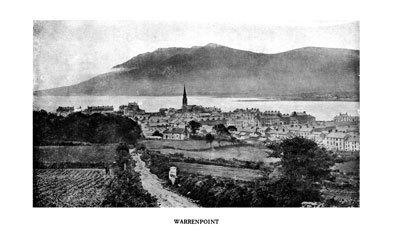
Warrenpoint -- The gate of the Mourne Mountains, within a few years, with a rapidity almost phenomenal, has reached the front rank of Irish watering-places. The town has a magnificent situation on the shores of Carlingford Lough, and the view of mountain and sea is sublime in the extreme. Warrenpoint has a noble expanse of sea front with a concrete esplanade, and close by are the Municipal Gardens, "a thing of beauty," complete with band stand and municipal tennis courts, which are open to visitors.
The Council has provided Open-air Swimming Baths, which furnish access to the open sea, and bathers may use either. There is a large fleet of rowing and sailing boats, and the Lough is eminently suited for this kind of amusement.
The golfer can here enjoy a game amid picturesque surroundings; the tennis enthusiast can play on the Municipal tennis courts; the angler can fish in the water-works reservoir and a dozen local rivers; while concerts, variety entertainments, etc., are given throughout the year. The picture houses supply the needs of the "Coogan" enthusiast, and dances and fancy dress carnivals are frequent.
Circular motor tours, with Warrenpoint as headquarters, are innumerable, and the archaeologist, geologist, historian, angler, and sportsman will find so much to see and to please, that the day of return to office work will be anathema.
Further information as to Hotels, Boarding Houses, etc., may be obtained on application to the Town Clerk, Warrenpoint, Co. Down.
Inland Towns of Co. Down.
Ballygowan -- Is a small village about eight miles from Belfast. It has long been renowned for its blue stone quarries -- "sett-making" being a remunerative occupation for the inhabitants. The women of the village do exquisite hand embroidery.
Ballynahinch -- A market town, thirteen miles from Belfast, was built in the reign of King Charles II. The Spa, about two miles from the town, has become increasingly popular as a summer resort. The grounds and puzzling walks, hot and cold sulphur baths, ballroom and restaurant, combine to make the Spa an ideal health and pleasure resort.
Excellent golf links lie close to hand.
Banbridge. -- A flourishing town, twenty miles from Belfast, lies on both sides of the Bann. There are four flourishing weaving factories in the town, and a large number of bleaching greens.
Castlewellan. -- A thriving town, four miles from the fashionable Newcastle, Castlewellan lies at the foot of a mountain, and on the shores of a beautiful lake abounding with trout. Here stand the massive mansion of the Earl Annesley and the picturesque residence of the Earl of Roden. The linen trade is the staple industry of the town.
Comber -- Is a market town, prettily situated in a prosperous agricultural district, seven miles from Belfast.
There are an extensive Spinning Mill, two Whiskey Distilleries, a Stitching Factory, and a Nut and Bolt Factory in the town.
Conlig. -- A village, 2½ miles from Bangor, is about a mile from the far-famed Helen's Tower in the demesne of the Marquess of Dufferin and Ava. Extensive lead mines were worked formerly in the locality.
Downpatrick. -- An important centre from the earliest times, Downpatrick is the principal and Assize town of County Down. It occupies a picturesque position eighteen miles from Belfast. The Cathedral Church, built on the site of an ancient Abbey, stands on a wooded eminence in the town, and the reputed grave of St. Patrick lies close at hand. There are regular steeplechase meetings held in the neighbourhood.
Dromara. -- A neat village on the Lagan, sixteen miles from Belfast.
Dromore -- Nine miles from Lisburn, is chiefly notable for its Parish Church, which was once a Cathedral. Buried in the Cathedral are Bishops Jeremy Taylor and Percy, the latter a friend of Dr. Johnson and Goldsmith. The town is gradually growing, and contains seven factories and one flax and two corn mills.
Gilford -- 4½ miles from Banbridge, is situated on the Bann, and above and below the town the banks of the river are extremely picturesque, being embellished with handsome country residences and well-wooded demesnes.
Hillsborough -- Four miles beyond Lisburn, has a fine park, enclosing a 17th century fort, in which William III. is said to have slept in 1690, and which is visited by large numbers of tourists. On the hill-top stands a monument to the 4th Marquis of Downshire.
The Maze Racecourse, an historic venue, has been long associated with Hillsborough.
The official residence of the Governor of Northern Ireland is Hillsborough Castle.
Killinchy -- A beautiful village, on the road from Belfast to Downpatrick, stands upon a splendid elevation surrounded by grand scenery. On one side is Strangford Lough, having an island for every day in the year; on the other are the remains of Scattrick Castle levelled by Cromwell.
Moira. -- A post town, situated on the Great Northern Railway. The Church is the main feature of interest. It is a large Gothic edifice, with a square tower, surmounted by a spire, and from its situation above the town forms a conspicuous and picturesque object.
Rathfriland. -- A market town, between Newry and Castlewellan, is noted for the ruins of an old Castle, anciently one of the fortified residences of the Magenises Lords of Iveagh, from which Lord Iveagh takes his title.
Saintfield -- A market town, four miles from Ballynahinch, was the scene in 1798 of a brisk skirmish between the rebels and a company of York Fencibles, at which the Yorks were massacred.
Scarva. -- One of the most picturesque spots in Ireland -- is on the main line of the Great Northern Railway. On the borders of the village is a fine old demesne, open to visitors, in which is annually fought the historic battle known as the Scarva Sham Fight. Scarva is noted for the purity of its water and its salubrious air, and is a favourite resort for those seeking health, as well as tourists and anglers. The Great Wall of Ulidia runs through Scarva, and in the neighbourhood are Danish forts with ramparts and entrenchments.
Waringstown. -- A clean and picturesque village, two miles from Lurgan.
Damask weaving is carried on in the village, whose streets are planted with beautiful plane trees.
^ top of page
COUNTY FERMANAGH.
The County of Fermanagh is not a large one, but it must of necessity make a great appeal to the historian, for here was the birthplace of two famous regiments; to the angler, for here he can play his fancy to the full ; and to the student, for here is the home of an unique industry-Belleek Pottery.
Ballinamallard. -- A rising town about six miles from Enniskillen, adjoining the Great Northern Railway.
Belleek -- Contains the only Porcelain Factory in Ireland, and is noted for the lovely Parian and other ware manufactured there. Belleek is charmingly situated in the midst of delightful scenery, and holds the sluice gates which were erected for the purpose of regulating the traffic between Upper and Lower Lough Erne.
Belcoo -- Is a pretty village about ten miles from Enniskillen. It can be reached from Enniskillen by car or by rail on the Sligo, Leitrim and Northern Counties Railway. The scenery all round Belcoo is very good. Lough McNean, the Marble Arch, and the Hanging Rock should all be visited. The Marble Arch, which is on the estate of the Earl of Enniskillen, is a beautifully wooded glen, in which will be found underground and open rivers and a number of remarkable caves. Permits to visit the Marble Arch can usually be obtained at the Estate Office, Middleton Street, Enniskillen.
Enniskillen -- The thriving capital of Co. Fermanagh is picturesquely situated on an island between Upper and Lower Lough Erne. It is an ancient and historic city, as its charter dates back to 1612 in the days of James I. It was the birthplace of two renowned regiments -- the 6th Inniskilllllg Dragoons and the 27th Royal Inniskilling Fusiliers, and still remains an important military centre and recruiting station.
The town of Enniskillen contains the Cathedral Church of the Diocese of Clogher, dating from the 17th century, which has as treasured relics the two flags under which the Inniskillings fought in the Peninsula and Waterloo, and the three flags borne by the 6th (Inniskilling) Dragoons at Waterloo. The old Castle of Enniskillen -- the scene of many a bloody affray in the troublous year 1594 -- is well worthy of a visit, and the Fort Hill or fortress, which has been transformed into a spacious pleasure ground, is a delightful and healthful retreat, while the Town Hall contains many interesting trophies.
Enniskillen Royal School, founded in 1626 by Charles I, is in many respects the premier Irish school, and the name "Portora" -- the popular name of the school -- is known far and wide.
Rowing and motor boats and motor cars are easily obtainable at Enniskillen. There are many places of great interest in the neighbourhood, and many beautiful motor tours.
The lake and mountain scenery in the South-West portion of Fermanagh is particularly fine, and the tourist should journey along the south side of the lake from Enniskillen to Belleek, passing Ely Lodge, the beautiful seat of the Marquis of Ely, Blaney Bay and Magho mountain, and return to Enniskillen via Garrison and Belcoo, passing Lough Melvin and Lough McNean.
In the same district the scenery on the hills is particularly fine. There are numerous lakes and mountains, and the circular tour from Enniskillen through Sandhill and Stratonagher to Glen East School, returning by Carrick Lake, should not be missed. There is also splendid scenery all round Knockmore.
Portora Old Castle -- a picturesque old fortress of the 17th century, Devenish Monastery and Round Tower, Tresna Island, which acquired fame by having until recent years a queen of its own, the old fortress of Castle Hume, the old 6th Century Abbey on the Island of Innismacsaint, the ruins of the Plantation Fortress -- Tully Castle, Castle Archdale, Castle Caldwell and White Island, which possesses a Church of curious architectural design -- all are on Lough Erne and within easy distance of Enniskillen, and are all well worthy of a visit. Upper Lough Erne, too, has many places of surpassing interest -- the chief of which are Lisgoole Abbey, Belleisle House and Crom Castle, the stately home of the Earl of Erne.
A first-class tourist hotel, standing on a hill overlooking the lake and surrounded on all sides by magnificent scenery, is situated about six miles from Enniskillen.
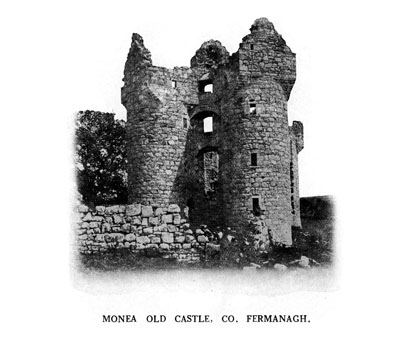
Arrangements are being made to run motor boats to and from Enniskillen to the Hotel.
Enniskillen Yacht Club Races are sailed on the lake beside Rossclare.
Enniskillen possesses an excellent golf course close to the town.
Further information as to Hotels, and Boarding Houses may be obtained from the Town Clerk, Enniskillen, Co. Fermanagh.
Knockninny -- Where there is an hotel, is a beautiful spot on the Upper Lake, about seven miles from Enniskillen. An immense mound known as "Knockninny Rock" rises to a considerable height from the lake shore. At the bottom of the rock close to the hotel is Ninian's Well, which is stated to contain very beneficial waters.
Garrison -- Is a village of rare beauty, situated about three miles from Belleek on the shores of Lough Melvin. It has two hotels and is a favourite resort for anglers. The scenery all round is good. The lake is famous for salmon and trout fishing. The "gilaroo" trout, which it is said is not to be found in any other Irish water, may be caught here in large numbers.
Irvinestown. -- The second largest town in Fermanagh.
Kesh. -- A small picturesque village on the Great Northern Railway.
Lisnaskea. -- Nine miles from Enniskillen, and half-a-mile from Lough Erne, is justly admired for its beautiful scenery, and its facility for anglers.
Pettigo. -- The town is situated partly in Co. Donegal (in the Irish Free State), and partly in Co. Fermanagh (in Northern Ireland), and within three miles of the celebrated pilgrimage of Lough Derg.
^ top of page
COUNTY LONDONDERRY.
County Londonderry enjoys many advantages. St. Patrick and O'Cahan are names interwoven with the history of the County, and history can tell no more famous stories than the sieges of the ancient City of Derry and the building of the ramparts around the City. The O'Neills, too, flitted across the stage in this County and left their trail of blood. To-day Londonderry is a prosperous County with many industries, where the sportsman can indulge his favourite hobby with ease.
Seaside Towns of Co. Londonderry.
Castlerock. -- A pleasant watering-place close to the Belfast and Northern Counties Railway line. There is a fine natural golf course, over 6,000 yards in length, which is a championship course where the Men's Irish Close, Ladies' Irish Close and Professional Championships have been played. There are also very good hard tennis courts, and excellent angling can be obtained in the neighbourhood. There is ample hotel and boarding house accommodation in the town, which is rapidly becoming one of the favourite resorts in the North of Ireland.
Londonderry is one of the few walled-in cities in the British Isles, and these walls are intact and in a good state of preservation to-day. It is the only city in the Kingdom which has preserved an intimate relationship with its benevolent foster-mother London for three centuries. Londonderry is pleasingly situated on the banks of the River Foyle -- the older parts of the City being built on a hill, the top of which is crowned by an ancient Cathedral. The City is surrounded by an ancient rampart, a mile in circumference, with seven gates. The leading thoroughfare, Shipquay Street, is among the steepest business streets in the Kingdom. The history of Londonderry can be traced to the days of St. Columba, and right down the centuries history has been made and re-made within its famous ramparts. The Irish Society rebuilt the famous St. Columba's Cathedral in 1633, and this Society, which formed part of, and yet was distinct from, the Corporation of London, has always taken and still takes a benevolent interest in the welfare of the City.
Londonderry successfully withstood three sieges in the 17th century, for which it gained the proud title of the "Maiden City." On the walls to-day can be seen some of the old cannons used in one of these sieges. including the famous "Roaring Meg," which throughout thundered defiance at the enemy.
The magnificent City Hall -- the Guildhall -- was built at a cost of £20,000, from 1887 to 1890, but was burnt down on Easter Sunday, 1908, and had to be rebuilt at a cost of £25,000. In the inner vestibule are several interesting statues and busts, including one of Queen Victoria, in Sicilian marble.
The chief industry is the manufacture of shirts, collars, and underclothing. It is estimated that the annual output of collars alone is 20 millions. Hosiery and knitted goods, ham and bacon curing factories, flour and meal mills, brass and iron foundries, boxmaking factories, mineral water factories and distilleries, all help to make the City of great commercial importance.
Londonderry is easy of access from England, Scotland and Wales, as there are direct rail and shipping routes, and a traveller leaving London at night can be in Londonderry the next morning at 11.
There are many well-appointed Hotels.
The McCrea-Magee College and Foyle College are two famous seats of learning.
Sportsmen will find much scope for their activities in Londonderry and district. Good hunting and shooting may be had in the immediate neighbourhood; anglers may have their choice of salmon, sea trout, and small brown trout in the rivers Faughan, Mourne, and Finn, and in the Newtownstewart district, where there is a salmon hatchery. Golfers can play their favourite game at Prehen at the links of the City of Derry Golfing Club, at Lisfamon, or after an hour's journey by rail on the famous links at Portrush, Portstewart, and Castlerock.
There are well-managed cricket, hockey, football, tennis, badminton and rowing clubs, and the picture-house enthusiast and opera patroniser are all catered for.
Further information as to Hotels, Boarding Houses, etc., may be obtained on application to the Town Clerk, Guildhall, Londonderry.
Portstewart (popularly known as the "Health Mecca") lies close to where the Counties of Londonderry and Antrim meet.
It is situate on the seaboard facing the entrance to Lough Foyle; the Donegal mountains, Innishowen and Glengad headlands resting in the background. To the north is Portrush and the world-famed Giant's Causeway, on the south it is bounded by a magnificent bay of unbroken sand over two miles long, the River Bann, and Magilligan headlands, whilst the Antrim hills afford protection on the east and north-east.
The most essential feature, however, of Portstewart, is its wonderful climate. The air is simply laden with ozone -- the western breeze gives a highly bracing effect, yet is soft and silky, the result being a delightful feeling of exhilaration. There are no extremes, frost and snow are rarely known in winter, the east wind with its biting sting is shut out, and in the summer the excessive heat is tempered by the cool breeze from the western ocean.
There are two excellent golf courses -- one of twelve holes and the other eighteen. Both are conveniently situated in close proximity to the town. Over and above the sporting qualities of the links, the picturesque beauty and bracing air make Portstewart a golfer's paradise.
Bathing facilities are abundant. The morning plunge in the "Herring Pond" or "Port-na-haple" exhilarates to a marvellous degree, and no better specific to brace the system for toil or pleasure can be imagined. Mixed bathing is allowed.
There has not been a single case of infectious disease in Portstewart for years, its bathing facilities, golf, electric light, water supply and other necessities, would reflect credit on many a larger community, all uniting to make it not only one of the most desirable of watering-places, but also an ideal spot for permanent residence. Come to Portstewart!
Further information as to Hotels, Boarding Houses. etc., may be obtained on application to the Town Clerk Portstewart, Co. Londonderry.
Inland Towns of Co. Londonderry.
Aghadowey. -- A small town near Coleraine. Valuable deposits of clay exist in the district, suitable for the manufacture of bricks, tiles and pottery.
Bellaghy. -- A small but interesting village three miles from Castledawson Railway Station.
Castledawson, twenty-four miles from Belfast, is delightfully situated on the Moyola River, and is only two miles from Lough Neagh. The river is crossed by a stone bridge of one arch, which is supposed to be the largest span in Ireland.
Castlederg. -- The town stands on the banks of the River Derg, in the centre of a thriving and prosperous agricultural country. It is connected by a steam tramway with the Great Northern Railway.
Coleraine is a prosperous town on the River Bann. Proximity to the seaside resorts of Portrush, Portstewart, and Castlerock renders the town a most desirable place of residence. The history of Coleraine can be traced in Irish annals through fifteen centuries, and in the 5th century St. Patrick founded a Church there called "Cuil Rathain," and the town therefore enjoys the distinction of having received its name from the Great Apostle of Ireland. The stapel industries are linen-weaving, shirt and collar making, iron-founding, distilling and salmon fishing. There are many fine buildings, and Hotel accommodation is ample and good.
Desertmartin -- A small village on the Draperstown Railway.
Donemana. -- A thriving and healthy village on the River Dennet, about nine miles from Londonderry.
Draperstown. -- A post town on the main roads between Derry and Tyrone. On the road to Omagh are the ruins of the old Church of Ballynascreen, said to have been founded by St. Patrick.
Dungiven. -- A small town on the River Roe. On a jutting rock, overhanging the river at a place known as the "Salmon's Leap," stands the old Priory, founded by Dermot O'Cahan in 1100, and within its roofless walls are the graves of the illustrious chieftain and his seven sons. The famous Altmover Quarries of freestone are in the district.
Garvagh. -- A pretty little town four miles from the River Bann, and nine from Coleraine. It is considered one of the prettiest towns in Ireland. It is also of historic importance, on account of it being the scene of one of the battles fought by Sir Phelim Roe O'Neill. Good fishing and shooting can be had in the neighbourhood.
Kilrea. -- A thriving town on the River Bann, famous for its salmon and trout fishing, which attracts an ever-increasing number of fishers from England, Scotland and Wales.
Limavady. -- A town of great antiquity and interest, situated in the middle of a fertile district. It was the residence of the celebrated O'Cahan, who was chief of one of those powerful "Septs" of Ulster that were so persistent and determined in their opposition at all times to the English.
Magherafelt. -- A flourishing market town thirty-eight miles from Londonderry.
Moneymore. -- The town, thirty-two miles from Belfast, is the centre of an extensive fruit-growing district.
^ top of page
COUNTY TYRONE.
County Tyrone is a large and rich agricultural County. The ancestral homes of many members of the peerage are situated here, and for the historian and antiquary it must have an abiding interest, as the County had a close personal interest in St. Patrick, and in later years in the time of the O'Neills was the scene of many a battle. There are great facilities for the angler, and the markets and coalfields supply signs of an industrious people.
Aughnacloy. -- The chief town in the famous Clogher Valley. At the head of the town stands the Jackson Almshouse, an imposing structure of Tudor design, built and endowed at a cost of £10,000.
Ballygawley. -- At the foot of Knockoney Hill, famous for its commanding view. Ballygawley River (close by), a tributary of the Blackwater, is famed for its splendid trout.
Caledon. -- A market town, known for its manufacture of woollens and tweeds.
Clogher. -- An Episcopal City -- though only a town of small proportions.
Coalisland, three miles from Dungannon, has large spinning, flour, and corn mills, and pottery and spade manufactory. The local coalfields are in process of development, and it is confidently expected that in the near future Coalisland will be one of the most important towns in the Province.
Cookstown. -- A flourishing market and manufacturing town at the termini of the Great Northern and Midland Railways. The markets are among the foremost in the Province. In the town and surrounding districts are numerous linen factories, spinning mills, tape factories, flax-scutching mills, and Co-operative creameries.
Drumquin -- Five miles south of Baronscourt -- the palatial home of the present Governor of Northern Ireland, the Duke of Abercorn. The town is mentioned in Irish history as early as the 13th century. Not far from the village are the ruins of "Kirlish" Castle, a Memorial of the Plantation under James I. in 1610.
Dungannon. -- A municipal borough, market, and post town, situated on a beautiful hill; it was the seat of the O'Neills from the earliest days, and on a hill crowning the town formerly stood a Castle erected by the chief of the O'Neills. The various markets are a feature of the life of this part of the Province.
Donaghmore, two miles from Dungannon, has an ancient ecclesiastical history, St. Patrick having built a Church there. On the village street there is a fine specimen of the Old Irish cross. Wolfe, the author of the Ode "Burial of Sir John Moore" was curate of the Parish.
Fintona. -- A most picturesque nine-hole golf course is one of the many attractions.
Gortin. -- A picturesque little town, ten miles from Omagh. The town is very ancient, and is composed of one continuous street with houses on both sides, and a bridge spanning the centre. The surrounding district abounds in minerals, including galena, plumbago and iron pyrites. The district is rich in archaeological remains.
Kelskerry. -- A village on the road from Trillick to Enniskillen. The old graveyard contains the remains of one of the O'Neills, King of Tyrone.
Moy. -- A small town on the River Blackwater, designed by the Earl of Charlemont in 1764, after the plan of Marengo in Italy.
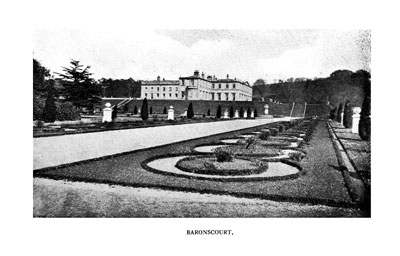
Newtownstewart. -- A pretty little town known for its proximity to the Ulster Governor's princely residence an demesne at Baronscourt, three miles distant. The district teems with interest for the antiquary, and there is good fishing on the Rivers Strule, Mourne and Derg. The Foyle and the Bann Fishery Company have a salmon hatchery near the town. Tourists have now an additional attraction in the golf links, the ground for which was given by His Grace the Duke of Abercorn.
Omagh. -- Situated on the Strule (a tributary of the Foyle), Omagh is the capital of County Tyrone, sixty-six miles from Belfast, and a military depot. The principal buildings are the Tyrone County Hospital, the Town Hall, Technical Institute. County Courthouse of Tyrone, and District Lunatic Asylum.
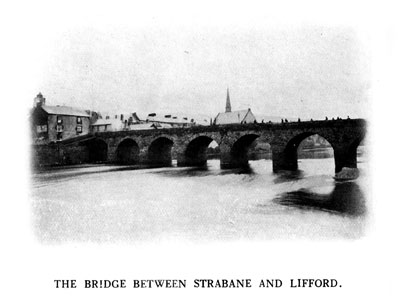
Strabane, an important market town on the River Mourne, eighteen miles from Omagh on the G. N. line, is an important railway junction. The district is of enormous historical interest. James I. granted the surrounding district to the Duke of Abercorn in 1611, when Strabane was only a small village.
Trillick. -- A neat little town on the leading road from Omagh to Enniskillen.
^ top of page
Some Places, Stories, and People.
One element in the happy blend of pleasures of a tour in any country is lost if the tourist knows nothing of its history and biography. A cottage and a garret are a cottage and a garret anywhere, but with what keener emotions are they regarded if we know that here Shakespeare was born, and there Chatterton died. Ulster is rich in history. Not a town, not a village, or hamlet, not a mountain or river or bay, but has its story or its legend; though as yet the Province has not found its Walter Scott, whose magic pen still draws visitors to Scotland till the commonest sight on Loch Lomond and Loch Katrine is the American tourist with his "Rob Roy" and "Lady of the Lake."
Run round the coast -- Carlingford and Strangford (fiord) with their memories of Danish invasions; Downpatrick and Dundrum with the Anglo-Norman conquest and their earlier stories of St. Patrick and St. Brigid and St. Columbkill; Bangor, the seat of a Monastery which did so much to spread culture throughout Europe that to the present day the Swiss Canton of St. Gall preserves the name of one of its missionaries; Holywood, the home of one of the greatest mediaeval theologians; Carrickfergus, with its ancient Castle and nearly seven centuries of war; Larne, where the Bruces landed for their Irish campaigns; The Glens of Antrim, with their battles of Scotch and Irish and English; Ballycastle, with its tragic memory of Macdonnell wringing his hands upon the strand powerless to prevent the massacre of his people on Raghlin a few miles out to sea, the same strand on which landed Deirdre of the Sorrows, and the same sea on which floated the children of Lir --
"Silent, O Moyle. be the roar of thy water,
Break not, ye breezes, your chain of repose,
While, murmuring mournfully, Lir's lonely daughter
Tells to the night-star her tale of woes."
Then there is Raghlin Island itself, where Robert Bruce learned from the spider the lesson of perseverance that led him to Bannockburn and the throne of Scotland; Dunluce, with its banshee and memories of the Armada --
"Grim fortress of the northern sea,
Lost are thy power and pride;
Within thy undefended walls
The folded sheep abide."
So one passes on to Lough Foyle and Derry, with their traditions of the Siege, and their older memories of the great St. Columba, who left his beloved Derry of the oak woods to found Iona and turn to Christianity the rude peoples of the mainland.
Or turn inland -- to Lough Neagh with its legends --
"On Lough Neagh's bank as the fisherman strays,
When the clear cold eve's declining,
He sees the round towers of other days
In the waves beneath him shining."
-- to Slemish, that mountain in County Antrim whereon the captive St. Patrick tended the swine of Milchu. One miht follow the Saint widely over the Province, from Templepatrick on the shores of the Channel, where one may see his footprint in the rock and drink from his well, to Saul (near Downpatrick), where he founded his first Church in a barn, whence the name. Then there are Gillhall and Drumbo, with two of the most vivid and circumstantial ghost stories in the English language; Galgorm, with an equally circumstantial story of a compact between Doctor Colville and the Devil, in which the Reverend Doctor was too wily for his sulphurous Majesty; Rostrevor and Killowen with their marriage romance that stirred the whole of the three Kingdoms; Armagh with its long history and the "barring-out" in its famous school as light relief; the Castlereagh Hills, with their Elizabethan and Stuart tragedies, and their modern land steward who preserved the old Castle by building a wall round it, but built it with the stones of the Castle, so that as the wall went up the Castle disappeared; Islandmagee, with its legends of the Rebellion of 1641, and its witchcraft of 1711.
These are not a tithe of the stories, and every spot to which foot, cycle, or motor can carry the traveller has its sermons in stones and books in the running brooks.
Ulster, moreover, has been peculiarly rich in notable men. It may have been due to the spur of the harsh environment or, more probably, to the admixture of blood -- Irish, English, Scotch, Norman, Danish, French -- that runs through our veins. Whatever the reason the fact remains, and what the Empire has owed to some of them is not easy of estimation. That Canada still flies the Union Jack instead of the Stars and Stripes is due in the main to Guy Carleton, a native of Strabane, who at the siege of Quebec was Wolfe's right-hand and one unfaltering and undoubting friend. When the War of Independence broke out it was Carleton who defeated the American invasion, and by his wise and kindly rule knit the ties which hold us still to-day. In India England owes as much to Ulster as she does in Canada, for John Lawrence, whose wise rule in the Punjab made the siege of Delhi and the recapture of India possible, was a Derry man; and John Nicholson, whose military genius and fiery courage recaptured Delhi, was a Lisburn man. Men of our Province have written their names indelibly in India. Another Derry man, Henry Lawrence, was only less famous than his brother, Sir Robert Montgomery, who disarmed the Sepoy regiments at Lahore, and thus choked the disaffection in the Lower Punjab. was (as were the Lawrences) an old Foyle College boy. In an earlier generation, Sir Henry Pottinger, of Belfast, was the explorer of Beluchistan, a wise administrator, an admirable ambassador in China, and his nephew Eldred, also of Belfast, was not only the "Hero of Herat," but also the officer whose tact and courage effected the release of the unhappy captives of the disaster of Kabul. In Comber stands a monument to Sir Robert Rollo Gillespie, whose career outpaces romance, associated with the mutiny at Vellore, where he was drawn up the walls of the citadel amid the fire of the mutineers, his death at Kalunga, crying "One more shot for the honour of Down;" being still a spur in the side of our young ambition. Moira is associated with the Marquis of Hastings, Governor General of Bengal, and Commander of the Forces in India, who first defeated the Gurkhas, and then made them the friends they have been ever since.
There have been many other soldiers of note. Scrabo Hill is crowned with a monument to the third Marquis of Londonderry, one of Wellington's men, who in Moore's words -- "put the proper spirit into the British cavalry." In far-away Enniskillen is a memorial to another of Wellington's men, the stout old Sir Galbraith Lowry Cole, who commanded the famous 4th Division. Rostrevor-way lay the home of Sir John Ross of Bladensburgh and Langford Lodge, on the shore of Lough Neagh, was the home of Sir E. M. Pakenham, both skilled soldiers before their names were lit by their American campaigns.
America, indeed, has other and kindlier associations with the Province. The torrent of emigrants that poured from here in the eighteenth century gave the land of their adoption industrious settlers, intrepid pioneers, and the backbone of Washington's Army. The roll of Presidents is rich in Ulster blood. Andrew Jackson, "Old Hickory," was of a family that came probably from the Kennedy estate between Newtownards, Bangor, and Belfast to dwell about Carrickfergus. The family of James K. Polk came from the County of Londonderry, and that of James Buchanan from Ramelton, County Donegal. Andrew Johnson is believed to have been of Ulster origin, and the family of the mother of Ulysses S. Grant emigrated from the Province in 1763. Chester A. Arthur was the grandson of Gavin MacArthur of Ballymena. The mother's family of Grover Cleveland sailed from these shores. Benjamin Harrison, also on the mother's side, descended from an Ulsterman named M'Dowell. William M'Kinley's family came from Dervock, County Antrim; and, once more on the mother's side, there was Ulster blood in the veins of Theodore Roosevelt. Last on the list is Woodrow Wilson, whose grandfather came from the neighbourhood of Strabane. Americans who know the history of their country will remember the names of Charles Thomson, born in Maghera, the "Man of Truth" of the Delaware Indians; of John Dunlap, born in Strabane, the printer of the Declaration of Independence; of Colonel Charley M'Dowell, Henry Knox, and John Armstrong; of Gilbert Tennent, of Armagh and the famous "Log College." Greatest perhaps of all who went from Ulster to those friendly shores was James Logan, a native of Lurgan, Penn's secretary and do-everything man in Pennsylvania. At the age of twenty-six he was left in full charge -- "I have left thee in an uncommon trust," wrote Penn, "with a singular dependence upon thy justice and care."
There have been sailors, too. Clandeboye, Ballyleidy as it was then, was the home of Sir Henry Blackwood, Nelson's bosom friend, the witness of his will, the eyes of his fleet before the battle of Trafalgar. Ballymoney was the birthplace of John MacBride, who, entering the navy before the mast, the son of a country minister and destitute of influence, died an admiral. It was also the birthplace of his brother David, a physician who devised a cure and preventive of scurvy, which had the honour of being tried by Captain Cook, who on that voyage lost not a single man from the disease. Holywood was the birthplace, and down the Ards peninsula, near Ballywalter, lie the bones of Arthur Lusk, one of Anson's sailors on the great voyage round the world, one of the crew of the open boat which lay six weeks beneath the burning sun in watch for the Spanish treasure ship. Castledawson was the home of Admiral Thomas Graves, second in command to Nelson at Copenhagen, whose name passed into a sailors' ballad-
"Our Commander-in-Chief, Admiral Parker by name,
And Vice-Admiral Nelson, that man of great fame,
And Rear-Admiral Graves, which drew up the rear,
While so boldly for Elsenore Castle we steer'd."
Another Ards man, General John Boscawen Savage, of the Marines, fought at the Nile. Just before the fight Captain Saumarez asked him to address his men. Savage did so. "My lads," said he; "Do you see that country? That is the land of Egypt, and if you don't fight like devils you'll damned soon be in the House of Bondage."
There have been statesmen and administrators. Lissanoure, County Antrim, was the home of Lord Macartney, the spoiled darling of fortune, Ambassador to Russia, Ambassador to China, who passed his life in the public service in an age of corruption without one penny of public money finding a dishonest path to his pocket. Milltown, County Armagh was the birthplace of Sir Robert Hart, the "I.G." Chinese Customs, for a generation perhaps the most powerful as he was always the most upright individual in the Far East. One goes back again to Clandeboye for the name of the Marquis of Dufferin and Ava. Viscount Castlereagh was another native of County Down, and George Canning, statesman and poet, who "called the New World into existence to redress the balance of the Old," was a native of Garvagh.
The Arctic and the Antarctic have felt the Ulster foot, for though Robert M'Cormick was born at Yarmouth he was of Ulster parentage, and a greater than he, F.R.M. Crozier, Franklin's second in that last voyage from which none ever returned, was a Banbridge man.
By way of contrast one can travel to Annalong and picture old General Chesney, who explored the overland route to India, and was christened by De Lesseps as the "father of the Suez Canal."
Science has the names of Lord Kelvin and his brother, born in Belfast opposite the Academical Institution in which their father taught. The Queen's University, Queen"s College it was in his day, is still proud of Andrews, whose researches into the liquefaction of gases were profound. Bangor can boast itself the birthplace of Dr. Reid Clanny, who invented a miner's safety-lamp before Davy or Stephenson. The little village of Killyleagh was the birthplace of Sir Hans Sloane, whose collections, purchased by the nation, were the foundation of the British Museum. The Geological Society owes its existence to William Babington, of Portglenone.
It adds interest to Ballyroney to know that it was the birthplace of Captain Mayne Reid, whose books delighted generations of boys; to High Street, Belfast, to know that here was born Sir Samuel Ferguson, who remains the greatest of Ulster poets; to Donaghadee to know that here was born Madame Sarah Grand, the English daughter of an English coastguard officer; to Rathfriland to realise that it was the original home of the Bronte family, and that County Down blood ran in the veins of the famous sisterhood.
To English Law Belfast sent Earl Cairns; Newry, Lord Russell; North Antrim, Lord Macnaghten. Surgery remembers the name of Sir William MacCormac of Belfast, and philosophy that of Francis Hutcheson of Drumlig.
The list could go on; this, too, is but a tithe; but enough has been said to indicate a people rich in the qualities a wise country seeks to foster. They are, moreover, a kindly and human folk, worth visiting, worth knowing, beyond most in their worth as a friend.
A. R.
^ top of page
Antiquities, and Natural History.
The botanist, zoologist, geologist, and antiquarian will find in Ulster a rich field of interest, of which, without further preamble, our synopsis may begin at Belfast.
Belfast. -- The most interesting prehistoric antiquities are two fine dolmens. The first, near Shaw's Bridge (Malone Road tram), is known as the Giant's Ring. The circle (if ever there was one) is gone, but the dolmen stands at the centre of a very large lis or earthen fort, The second, still larger, with a very massive capstone weighing 17 tons, is close to Dundonald Station on the B. & C.D.R., and may also be reached easily from the electric tram terminus. On the slope of the Belfast hills at Crow Glen, there are the remains of a souterrain, near Whiterock, some remnants of "rock shelters," in the taluses of which some important finds of a paleolithic culture type of flint implements have quite recently been found by a well-known local geologist. Neolithic types of flint implements are abundant in places near chalk outcrops north-west of the City. At Drumbo, in the Lagan valley, there is a fine round tower, and in the same district a vitrified and some other forts, and a Bawn or fortified farm house at Hillhall. Cave Hill is crowned with the finest prehistoric hill fort in the North-East -- McArt's Fort, well seen from steamers approaching the Harbour, and there are a number of duns or earthen forts in or close to the City, with a fine tumulus not far from the great dolmen at Dundonald, and a large kistvaen at Roughfort. The great holed menhir at Holestone, Doagh, is probably the finest in Ireland.
Carrickfergus is famous for its great Anglo-Norman Castle; the stone on which King William III. landed on his way to the Boyne in 1690; the old North Gate and fine old Church with the Chichester and other memorials.
Kilroot. -- Here may be found many fine early prehistoric flint implements, of the famous Larne types, in the fields and along the shore. Portions of Dean Swift's old rectory, and the columbary in the garden still stand with a very ancient font in the graveyard. At Cloughan Point are fossiliferous glacial gravels, and a fine section of a raised beach containing flint implements. The Triassic marls on the beach are riddled by several species of PHOLAS.
Whitehead. -- Between the town and Blackhead are two fine glacial erratics on the shore, and near the coastguard station a good fossiliferous section in greensand. Many rare minerals have been found in the basalt quarries. (See the Mineral Collection. British Museum.)
Ballycarry is the station for the Gobbins Cliff Path, and close to it along the shores of the Lough, on both sides, many fine flint implements are found. The basalt lava flows show very clearly along the Cliff Path, and zeolites are abundant.
Magheramorne is best known for its Estuarine Clay fossils, abundant in the clays thrown up along the edge of the great quarry tip of the cement works, Some good landshells occur on the older tip and Cretaceous fossils are abundant in. parts of the great quarry.
Larne -- the Ulster end of the short sea passage -- has long been famous for its raised beach gravels, full of worked flints, clearly shown by Knowles and other authorities to be of two ages, implements showing a paleolithic culture being present. Olderfleet Castle, where Edward Bruce landed in 1315, is now in ruins, and close to the Islandmagee ferry is one of the finest dolmens of the many in Antrim. Killyglen, a few miles inland, is another fine implement-collecting locality, so are many localities in Glenwherry, and the naturalist finds the great cirque of the Sallagh Braes equally good for Botany and Zoology. On the famous Coast Road from Larne to Cushendall are many antiquities, geological sections and natural history collecting grounds, the long talus slopes from the cliffs where the Chalk is slipping seaward over the soft Liassic clays, providing many sanctuaries for the remnants of the ancient Irish woodland fauna and flora. At Ballygally Head, very massive columnar basalt may be observed, "The Corn Sacks"; and near at hand O'Halloran's Castle on its isolated rock, with Ballygally Castle, a fortalice of the Scottish baronial type, close at hand. Inland may be seen a fine volcanic rock, Scawt Hill, and approaching Glenarm the fine chalk cliffs break up over the Liassic clays, and provide a number of natural curiosities of which the Madman's Window is the most prominent. The marine rock-pools are often good collecting grounds in spring and summer.
Glenarm itself has a very ancient history, and had an abbey; the old Bridge and Barbican Gate of the Castle should be seen; Glenarm Glen is the most southerly of the nine "Great Glens of Antrim," most of which open out from the Antrim Basaltic Plateau to the sea, cutting down to the Triassic rocks or the ancient pre-Cambrian schists of north-east Ulster. At Carnlough the road runs over a raised beach area, the fields of which yield many implements, and on the hills above are several prehistoric memorials. Drumnasole Glen has a short underground stream, and at Garron Point the great Garron landslip, two miles long, can be examined. The Garron Tower Hotel sits on the down-throw plateau close to Dunmaul, the prehistoric hill fort, where the Ardrigh, or chief king, at one time received all the rents of Ireland. The finest Eucalyptus tree in Europe grows in the Hotel gardens, well sheltered by the great cliffs above. The old native hillside woods here provide fine collecting ground for the naturalist.
Red Bay. -- Between Garron Point and Glenariff, the basaltic cliff range offers fine opportunities for the artist and amateur photographer, the many little farm houses nestling at their foot providing fine fore~rounds. Near this the greatest of the Antrim Glens, Glenariff, the "Vale of Shadows," opens out to the sea. Botanists will find much of interest in this and all the other great and subsidiary Glens north of it. Between the Vale and Cushendall the road passes through a natural arch in Triassic conglomerate, above which are raised beach caves, and the remains of Red Bay Castle. A mile further on there are Jasper veins in the rocks on the shore close to Cushendall Strand.
Cushendall. -- The town itself, near the foot of Glenballyemon and Vale of Cushendall, has an old fort, a curfew tower, and near it Layde old Church with a hole-stone memorial, and the very prominent Volcanic Neck of Tiveragh, a cone rising through Old Red Sandstone.
Cushendun. -- At Cushendun may be seen fine caves in O.R.S. conglomerate, an old castle, menhir, and cairn. A little up the Glen is "The Altar in the Wood," an old stone altar of the penal days, and on Tornamoney Point are two prehistoric cashels (stone forts) and quarries where the famous Tornamoney Eurite can be collected. On the way to Ballycastle on the moorland below the Glendun glacial overflow channel, down which the road runs, may be seen the vanishing lake -- Lough-a-veema -- which in dry weather disappears through an underground channel in the Chalk to the Carey River far below. The area to west of the road between it and Glenshesk, especially near the Owencam River, yields a very archaic type of massive flint implements now under discussion in scientific circles, they are not unlike some recent discoveries in East Anglia. Approaching Ballyboy to the right may be seen a conical hill with a small stone circle (a true cromlech) on the summit, and also the plateau of glacial gravels cut through by the Carey River, a portion of the great moraine that stretches from Gleridun dry gap to Ballycastle. Very interesting geological sections near this point will be described in the new geological memoir.
Fair Head. -- At Ballyvoy the road to the right turns up to Benmore or Fair Head (636 feet) with its great mural cliffs and many erratics, Grey Man's Path, a fault ravine in the mural cliffs, "up which Fir Leith, the Grey Man of the North Sea, comes up on dark stormy nights, when he comes to visit Ireland." The Crannoge Lake has one of the finest stone crannoges in Ireland. South of this is the beautiful Murlough Bay, a fairyland of glens, woods, cliffs, volcanic dykes, fretted by marine action into picturesque sea stacks, and the best deep marine pot holes in the county, many with nature's drills still in them. Sections of the boldest sub-cretaceous conglomerate in the United Kingdom show well in the cliffs round the bay. (See Hume's "Cretaceous Rocks of Antrim," in Journal of the Geol. Soc. of London, 1897.) Tor Head, near the bay, is only 14 miles from the Mull of Cantyre in Scotland, and on it is a Lloyd's signalling station. Between it and the Mull is that turbulent tide run the Waters o' Moyle, with their many legends.
Ballycastle -- about five miles from Fair Head -- is a fine centre for both Glen and coast tours. Bonamargy Abbey, the last of the pre-Reformation Abbeys, stands close to the golf links, strand, and tennis courts. Rathlin Island, with its fine cliffs and caves, the Round Tower of Armoy, Glenshesk, Kenbane Head, Old Castle, and the Rope Bridge of Carrick-a-Rede, may all be visited from Ballycastle; and on the way to the Giant's Causeway, the cliffs, caves, and prehistoric "Kitchen Middens" of Whitepark Bay, which have yielded so many fine stone implements, bones of the Great Auk, Great Grey Seal, Red Deer, ornamental pottery, etc., in years gone by and still do. A small tumulus, with its stone circle, may be seen close to the Middens. Port Braddan, a very picturesque little salmon fishery at west end of the bay, is formed at the east end of the great geological fault throwing down the basaltic rocks of Bengore Head (the Giant's Causeway area) against the chalk cliffs of White Park.
Giant's Causeway. -- This is fully described in the alphabetical section of County Antrim.
Portrush. -- The geologist will find good sections, including the classical indurated Lias Clays near the fishing harbour, and the curious laminated submerged peat beds on the West Strand. The botanist will find the East Strand sand dunes good collecting ground, and on both Strands after prevailing westerly winds many pelagic shells and other marine treasures come ashore, occasionally in quantities, such as IANTHINA, and the beautiful pearly Ram's Horn SPIRULA PERONII from tropical seas, which now and then in late summer forms a tidal fringe all the way to the Whiterock caves, with many Pteropods, Foraminifera, and the European Cowrie, TRIVIA EUROPAEA.
Portstewart, on the Bann, between Portrush and Coleraine, has an old Castle and a famous shell strand. There are good Holocene age landshell deposits in the extensive very old dunes, and the Kitchen Midden areas here have long been famous for their implements, pottery, etc.
Coleraine has an ancient history and, near the Salmon Leap on the Bann, a fine prehistoric fort. Botanists will find the marshes along the river worth attention, and the river gives a good assortment of fresh-water shells, including PALUDESTRINA JENKINSI in myriads, and the curious Lough Neagh basin form of PLANORBIS CARINATUS.
Castlerock -- near the Bann mouth -- has also a fine shell strand, and the dunes beyond the golf links have yielded many prehistoric implements. Very large numbers of the bivalve CYPRINA ISLANDICA come ashore near mouth of the river, with TORNATILLA and IANTHINA.
Magilligan Point -- with its great shell strand -- may be reached via Magilligan Station, Downhill Station being nearer the east end. The fine cliff range of Benevenagh, with its alpines, is a little further south from Bellarena Station. Some rare minerals are found in the zeolitic basalts of the cliffs.
Dungiven. -- Limavady Junction is the change for those who wish to visit the Vale and Gorge of the Roe, with Dungiven Abbey, Glens of Banagher, and Banagher early Christian Church, kistvaen, etc.
Londonderry. -- At Culmore Point the Foyle River is reached, a few miles north of Londonderry, where there is much of interest to the antiquarian tourist or antiquary pure and simple. The old walls, with their bastions and guns, round the ancient city are intact; some of the old gates remain, also the Cathedral of the Siege, lately restored. The Chapter House is a museum of objects connected with the Siege, or the history of the City, many of great interest. Not far from the City, on the summit of Greenan Hill, is one of the two finest cashels or stone forts of prehistoric times now left in Ireland, and there are other memorials of minor interest in the district easily reached. These are described in the local guide books. They include some tall Celtic Crosses, a fine Castle in ruins at Greencastle, and some dolmens on Inch Island.
Strabane. -- Coming South to Strabane, with its fine old bridge and beautiful cliff-lined glen, a visit could be paid to the dolmen at Artigarvan, or the fine stone circle on the "Tops of Raphoe." both easily reached from the town, in which fine agricultural shows are held annually. Here peasant industries form a special feature.
Newtownstewart. -- Baronscourt, the stately home of the Duke of Abercorn, Governor of Northern Ireland, is not far from Newtownstewart; a fine old Castle now in ruins stands in the woods of the great demesne, and there is a fine dolmen not far off with a double chamber and another close to the town, where there is also an old Castle. The rivers here in North Tyrone are full of fresh-water pearl mussels and fine pearls are often found. with large numbers of seed pearls. The ancestral home of the Armour family of Chicago is still standing at Drumquin, near Newtownstewart. The Rev. Samuel Armour, great-grandfather of the Philip D. Armour, who founded the great packing firm, was ordained in Drumquin Presbyterian Church in 1812. His son, James, emigrated to the U.S.A.
Enniskillen. -- Still travelling south, Enniskillen, a very picturesque town on an island, which divides Upper and Lower Lough Erne, in County Fermanagh, is the next place of special interest. It has an old Castle in the Castle Barracks in the town, a Royal School, and another old Castle -- Portora -- in the grounds of the last, on the lake shore, which commanded the narrow entrance here to the Lower Lough Erne. Near it is Devenish Island with its old Abbey and remains of a very ancient Church, Cross, and the famous Round Tower, the most perfect in existence.
SUCCINEA OBLONGA, one of the rarest and most local British amber shells, has many stations on the Lower Lake -- one, two miles long, and two of these are on the lake shore close to the town. Monea and Tully old Castles can be reached from Enniskillen, and are well worth a visit; so, too, are the prehistoric caves in the Knockmore cliffs, and the inscribed rocks near Boho Chapel, with its bullaun marked cross shaft, the chambered tumulus on Belmore mountain (a guide necessary there), the dolmen and fine table erratic in the hills above Blacklion, the botany of the lake shores and islands, with the Boho caves, "The Dogs," and other places of interest to geologists. There were many crannoges in the shallow extensions of the Lower Lake explored by Plunkett and Wakeman in the middle of the last century. There are many others in the area not yet touched, awaiting investigation.
Newtownbutler. -- Before turning now east by the Clogher Valley in South Tyrone. a run south in Fermanagh to Crom old Castle, near Newtownbutler, might be made to see it and the famous old yew of Crom spread out over a large area. It was old when The O'Neill took leave of his lady love under its branches in Queen Elizabeth's reign. At Wattle Bridge near the back gate of Castle Saunderson, not far from Newtownbutler, there is a very fine stone circle. There are many minor antiquities and some of special interest, such as the fine chambered tumulus on summit of Knockmany Hill in the demesne of Cecil Manor, near Augher, two stones at least of which are covered with archaic sculpturing. At Caledon there is an old Celtic Cross now over the Holy Well in the demesne.
Tynan. -- In Tynan village, near at hand, is a fine tall Celtic Cross, with three others in Tynan Abbey demesne -- one on the avenue, one close to the house in the Yew Terrace, and the third on an island in the lake (reached by a rustic bridge).
Armagh. -- The primatial city with its old and new Cathedrals, Palace with many historical pictures, an old Abbey and fine oak-panelled private chapel, is well worth a visit. There are many fossiliferous limestone quarries near the City, and the great prehistoric Navan fort is only a few miles away. Many other interesting places are easily reached. including Benburb Castle, on the Blackwater, a place of great historic interest.
Portadown a busy manufacturing and market town, has nothing of antiquarian interest; but the River Bann, between the town and Lough Neagh, has yielded rare and local fresh-water shells. Boats are easily obtained for dredging. At the mouth of the river at Lough Neagh, the quickly spreading PALUDESTRINA JENKINSI now occurs in myriads.
Lurgan is a centre of the linen trade, and not far from it is a quaint handloom weavers' village, Waringstown. with its 17th century settlers' house, old Church with an oak shingled spire, very rare, if not unique in Ireland, and an interior with old oak pews and crammed with oak carving, by a former rector.
Lisburn, another linen trade town, a Huguenot settlement, has an old Cathedral, and near the town a long sinuous glacial gravel esker, in the upper layer of which many neolithic worked flints have been found, within lower levels, specimens which look suspiciously like human work in some cases. There are, however, strong differences of opinion on this point.
Newry, at the head of the Newry River Gorge, which opens out to Carlingford' Lough, has a very ancient history. It had an Abbey in days gone by, a small remnant of which remains; both a river and canal flow through the town. Above the west door of St. Patrick's Church may be seen the arms of Sir Nicholas Bagnal, the Seneschal of the Exempt Jurisdiction of Newry and Mourne. They are dated 1578. He was the ancestor of the Earls of Kilmorey, Lords still of that Exempt Jurisdiction. a large portion of which is still known as the "Old Kingdom of Mourne," with Kilkeel as its capital. Near Newry an old Celtic Cross -- St. Ercs -- which stands over a souterrain may be easily reached, and the Crown Fort, an exceptionally fine prehistoric dun near the Rathfriland Road.
Warrenpoint, on the almost land-locked Carlingford Lough, has many attractions. The mountain views from it are fine. At the ferry over the Newry River stands old Narrow Water Castle, a fortalice, guarding the pass in days of old. The modern castle close at hand has a fine rock garden, and much old timber in the demesne. Close to the boundary at Burren there is a small dolmen. The great dolmen, twelve feet high, with a 46-ton capstone, at Ballymascanlan, may be reached by a good walker from the Louth side of the ferry. There is a large kistvaen also in the same field. The dolmen is claimed to be the finest in the British Islands, though there are others with much heavier capstones, but not standing on such tall slender supports. It is also known as the Proleek Stone.
Rostrevor has two ancient Crosses in Kilbroney old graveyard, an early Celtic bronze bell in the Parish Chapel, and on a hill above the town a very fine glacial erratic of Newry (Silurian) granite resting on tilted slates, 900 feet above its parent bed. It is known as Cloughmore. i.e., the big stone.
Killowen -- near Rostrevor -- still has the old Chapel, where the Yelverton marriage took place, leading later to the celebrated Yelverton marriage case in the Law Courts.
Passing up the Hilltown Road from Rostrevor, fine views are obtained looking back to Carlingford Mountains, the summit of which is composed in part of a very coarse gabbro. This mountain has received special attention from Dr. Sollas, F.R.S., and other well-known geologists, owing to the complex nature of the rocks forming it, partly caused by volcanic intrusions. Botanists find much to interest them in this drive, or walk, through the Mournes, via Hilltown to Bryansford, near which on the road to Lough Islandreavy, there are the remains of many Cashels, the best of which has a large high souterrain in the centre, the habitat of the Cave Spider, META MENARDII. On the way to Newcastle a prehistoric fort is passed on the right, and on the left a few miles away the Cashel and ancient Church of Maghera, with the remnant of the Round Tower. The raised beach platform of Dundrum Bay runs inland to Maghera, three miles from the coast, and at Newcastle the storm ridges of this area are well exposed in the dune valleys of the golf links. Extensive Kitchen-middens occur all the way to the Inner Bay of Dundrum, and many finely worked flint arrow-heads, hollow scrapers, etc., are found in the dune hollows, with some pottery and an occasional anvil stone, or celt.
Dundrum has an Anglo-Norman Castle, with the finest circular keep in Ireland, crowning a high hill. Near it are the remains of an Elizabethan house, and at Sliddery-ford, one of the finest dolmens in Ulster, with a very massive tall menhir and good souterrain close at hand. The last is usually closed up.
Downpatrick, the next stopping place, the burial place of St. Patrick, St. Brigid and St. Columbkill, has the finest Norman mote in north-east Ulster. It is from this that the County Down takes its name (i.e., a dun or earthen fort). The Cathedral is a remnant of the great Abbey, which once crowned the hill, and close to it are the partly restored market cross and the reputed grave of St. Patrick. A vault of the old Castle still exists in the town.
Inch Abbey, a National Memorial now, and the Holy Wells of Struell are not far from the town. The great stone circle of Ballynoe, Lough Mong dolmen and menhir, Quoyle Castle, and Sampson's Stone (a great basaltic erratic) are easily reached.
Ardglass has a number of old Castles, fortified houses, really, of the London, etc., merchants who traded here in mediaeval times, as they did in Carlingford, where the Government destroyed a number of similar Castles during the rebellion of 1798. On Ardtole Hill there are an old ruined Church and a souterrain, 126 feet long, ending in a pear-shaped chamber. Another long one is at Church Quarter -- these are not always open. Another fortalice, one of the many round Strangford Lough, may be seen on the way to Strangford Ferry, Kilclief Castle, it still has an old roof on it, with interesting details. On way to it the road passes near Ballyhornan arid Benderg Bays, the low cliffs of which are formed by glacial gravels, loosely calcreted into a conglomerate, with some finer sandy and gravelly beds, irregularly deposited in the coarser conglomerate. Some fine examples of glacial planing and scratching are seen on the rocks on shore near high water mark.
Strangford. -- Before crossing the ferry to the Ards peninsula, three other old Castles may be seen -- one near the ferry and two in Castleward demesne, one of them used as a barn in the farmyard, the other near the Yew Terrace and Templewater. Permission to visit the last may be required.
Portaferry. -- On crossing to Portaferry another ruined Castle may be seen, the remnant of an old Church, and, a few miles from Tara Fort, Quinton Castle (restored), and also on the outer coast, a small stone circle close to the road. The geology of the Silurian and Ordovician rocks of this peninsula are well described in the Government Geological Memoir dealing with East Down. Further up the peninsula -- going North -- we pass the best of all the Castles of the Strangford Lough area -- Kirkistown Castle, with a towered bawn wall surrounding it. It stands on a bare flat raised beach platform without a tree near it -- a most conspicuous object.
Greyabbey. -- At Greyabbey there are the ruins of a Cistercian Abbey, conserved lately by the Board of Public Works, one of the finest, if not THE finest in Ulster. Near Greyabbey, on the shore, there is a very large glacial erratic, weighing over 100 tons, and in Mountstewart demesne a dolmen, strictly speaking the central chamber of a large cairn covering many stone cists, removed over 100 years ago. Between this and Newtownards the road passes another large erratic of basalt resting on Triassic sandstones on the shore. It is known as the Butterlump, and weighs about 36 tons.
Newtownards. -- There are an old cross base, a Priory with an interesting doorway, and an old Abbey Church at Movilla (a National Memorial) with some Anglo-Norman grave slabs and the finest Celtic inscribed one in the north-east. These are built into one wall by the Board of Works.
Donaghadee, a few miles east, on the coast, has an old tumulus known as the Moat, and some sections in rocks on the shore yielding graptolites. (See Swanston and Lapworth on the Silurian Rocks of Co. Down, published by the Belfast Naturalists' Field Club, The Museum.)
Bangor. -- At Bangor an old castellated building may be seen near the harbour, and at Ballyholme the sea terrace covers an extensive raised beach which had yielded many fossils, worked implements of the Larne type (patinated chalky white) and abundance of small erratics of Ailsa eurite (Riebikite), many of which can be collected on the shore near the old road bridge now a ruin. The strand here has many marine treasures, especially after eastern or north-eastern gales. At low water submerged peat is exposed and many bivalve shells may be dug out alive. The old Church of Bangor has some interesting monuments and other details. At Helen's Bay, a few miles away, at dead low water of spring tides, and other bays near it, the pure white form of the Top Shell, CALLIOSTOMA ZIZYPHINUS, usually so very rare and local, may be found, as it may also at Portaferry and among the islands of Strangford Lough.
Comber may be reached by motor, via Newtownards from Bangor, and also direct from Belfast by rail. Here motors or cars may be obtained for the Visit to Nendrum Celtic monastery, with its old crosses, cashels, and remains of Round Tower, Church, schoolhouse, fishponds. etc. It has lately been dug out and conserved by the Archaeological section of the Belfast Natural History Society. There are an old Castle close to the Monastery, and remains of another on Sketrick Island, a mile or two further down Strangford Lough, and a third in the farmyard at Ringhaddy.
The fine volcanic sills in the Triassic sandstone quarries on Scrabo Hill are well worth the attention of geologists, who may find some nice ripple-marked and rain-pitted sandstone specimens in the quarries. These sills are figured in the Belfast Geological Memoir, 1904, with other important local sections. Scrabo may be reached from either Newtownards or Comber Stations.
R. J. W.
^ top of page
Angling in Ulster Waters.
My foreword to English or Scottish readers of these Angling Notes is to tell you that, unless you have been here before, you cannot realise the enormous difference that exists between Ulster and cross-channel angling, so far as trouting is concerned. As one who has spent most of his leisure in angling in Scotland, England. Wales and Ireland, I speak from practical experience. To those accustomed to "across the channel" restrictions on every side, and to the heavily-fished waters there, our Ulster rivers will come almost as a revelation. Here there is scarcely a river, stream, or burn that does not hold its supply of trout, and, with a very few exceptions, angling is open and free to all comers. There are three or four rivers on which some restrictions exist. The lower reaches of the Ballynahinch River, in Co. Down, are preserved by an Angling Association, while the upper waters are free to all, and in them are some grand trout. On such a small river (where only a 9 or a 10 ft. rod is necessary) there have been brown trout of over three lbs. weight killed this season. That is within sixteen miles of Belfast. The lower three miles of the River Maine, Co. Antrim, is also preserved by the same body. and a few miles of the Bush River, Co. Antrim (near the sea), are reserved for salmon fishing. Apart from these three instances, it is only where a river enters a private demesne that any restrictions exist, as, for instance, the lower waters of the Glenarm River, Co. Antrim, which are retained by the proprietor of Glenarm Castle, for salmon and sea trout fishing.
Elsewhere, wherever his wanderings take him, the angler will find absolutely free trouting in river, stream, or burn, with a good supply of trout, despite every drawback, if he knows how to fish!
As more than ninety per cent. of visitors will arrive in Belfast, I propose to make it the hub of a big wheel -- the four spokes of which are four grand rivers all within a reasonable distance of Belfast. There are quite a dozen or more of smaller streams round about full of nice sporting trout, averaging at least six ozs.
THE LAGAN.
Let us begin with the Lagan. "What?" you will say -- "That River! With its steamship traffic, its mud and pollution, and its Gasworks' effluent?" Yes. Even so. Now, how many of you could believe that I have killed sea trout of 2½, 2¼, 2, and 1½ lbs. weight, on two evenings, on the fly WITHIN THE CITY BOUNDARY. Certainly I didn't eat them, but had the sport of raising, hooking, playing, and, finally, netting them, amid the most charmingly sylvan and peaceful surroundings imaginable; and this WITHIN A CITY of 400,000 people, of whom not more than three or four were present! I mention this to show in what improbable places trout may be taken.
I could show you, on the same river, five miles up, good trout rising on a warm evening. Within an easy ten miles of Belfast (still on the Lagan) I have repeatedly killed, on the fly, brown trout over two pounds weight.
Now, come up with me another five miles and share in one of my golden memories. The previous night I had tied half-a-dozen olives (of a rather peculiar type), and, liking their looks, and the direction of the wind, I was eager to test them. We will go to Moira (fifteen miles from Belfast), and, beginning at the Town Bridge, let us fish down. The month is April, the wind-west, the day -- mild, with a nicely dappled sky. Yes, the trout are already rising, and as I had expected, to an olive-dun. Hastily fitting up, I put the olive on the tail. Let me cover that one under the far bank -- a short cast. The tail fly drops a few inches above him, and, instantly he is fast. We wander on downwards, seeking rising fish, and as trout are feeding freely; it begins to dawn on us that I might begin to select the best of those rising. By watching the rings. I select only decent sized fish, and the little olive continues its deadly work, and the bag begins to feel heavy on my shoulder.
Retracing our steps, we fish on upwards, until, when nearly a mile of river has been covered, the ample bag refuses to hold more, and the eyelets have to be drawn together with string to prevent the trout from slipping out, and I am satiated with slaughter. But it was only when I reached home that I realised the chance I had missed of making my record "bag."
I had trout of 2lbs., 1¾ lbs., 1½ lbs., down to a ¼ lber ; with a total of 24 trout weighing 18½ lbs. A fine "bag," but it might have been better, had I "selected" from the start. That was on a Tuesday, and I went back on the Saturday, hoping for the same luck, and to try "selection" this time. I had another good day -- the olive dun was still on -- so my little olive did its work, and the net result was twelve trout, weighing 12½ lbs.
Now, isn't that good enough for a river that is free to all, and within fifteen miles of a great city?
I have no desire to figure in the lime-light, or to weary my readers, but there's one other strange experience that I must give you. Kindly note -- this is no "Fisherman's Yarn." Those who know me most intimately would vouch for my statements regarding fish and fishing.
A good many miles further up this river (the Lagan), a friend and I located an almost "virgin" paradise for anglers, as regards trout. This we christened "Klondyke," as being a veritable "gold mine." It consists chiefly of a series of long deep pools, almost dead water, only fishable with a breeze to ripple it, otherwise it is hopeless. An early start on the "bike" precluded any accurate forecast of what the day would be like, but the month was April, the hawthorn buds were bursting, and all sorts of possibilities existed.
On my arrival, I found the water just a series of sheets of glass, with brassy blue sky above, a shrewd "nip" in the air, and never a sign of fish life anywhere. Things looked hopeless, so I fitted up leisurely, threw the flies on the water to soak, lit a cigarette, and sat down on a bank -- to await a breeze -- and to see what that big slatey-grey cumulus cloud, rising in the North, might mean.
Gradually it spread; the heavens darkened, and in a minute or two I spied a big white feather floating lazily down. Then, another and another, till in a few minutes there was a miniature snow storm on, accompanied by a slight breeze.
Then began a sight such as I had never seen before, or since. Wherever a big flake touched the water, up came a trout.
Rising at snowflakes! I watched carefully, but there was no mistake; the rises were at the big flakes. It amazed me; but, picking up my rod, I began casting at these rising trout, and, by watching their rings, could "place" the best fish. And now began some glorious sport. Every time the fly fell within a foot of a ring, the fish was on. There were no misses; no false rises. They meant it, and they all took the tail fly (that little olive again); and I might just as well have been fishing with one fly.
When the short snowfall had passed, the sun shone out and the slight breeze passed away, only to find me "fast" in a last good fish (well over a pound), and I had the unique experience of playing a trout in brilliant sunlight and dead calm clear water, so clear that I could see his spotted sides and the swing of his tail as I piloted him and my cast safely past the visible, but still submerged lily-pads, and so into the net. During that brief snowfall I had hooked and landed eleven trout, weighing 11 lbs. 2 ozs.
Further up, still, round Dromara they average about six ozs., but are very game and fairly plentiful, with an odd ½ lb. or ¾ lb. as a big fish, and, very occasionally a good one of, say 1½ lbs., which usually falls a victim to a well-scoured worm!
Further up, still, you are right in the mountains, where it is simply glorious! What if the fish be smaller? The lovely untrammelled wildness of one's surroundings is delicious, and you forget city life and its worry; and fill your eyes and heart with the beauty of loneliness, and nature, on the foothills of Slieve Croob. The memories of a day spent up there are a lasting delight!
NOTE. -- Maze (10 miles), or Moira (15 miles), for lower reaches of Lagan, by road, or rail, from Belfast. Dromore (18 miles), up, and down, for middle reaches, by road, or rail, from Belfast. Dromara (6 miles) from Dromore, drive.
A 10ft. rod covers any part of this river. Open from February 1st to October 31st.
THE UPPER BANN.
The second river of our "Big Four," viz. -- the Upper Bann, rises on the slopes of the Mourne mountains, and flows into Lough Neagh. It is well stocked with beautiful yellow trout of a good average size and of fine sporting qualities. Throughout its course from above Hilltown to below Banbridge it is fishable, although few outside local anglers try for the big fellows that dwell in the deep still waters around Banbridge. They are seldom taken, except at night, and then with a big natural moth, dapping, or floating. Around the Corbet, both above and below, are some good rapid runs and broken water closely associated with the still deep. Just the place to look for a big one.
I should have told you that the Upper Bann trout differ from those of the Lagan. In both cases they take the fly well, but, while Lagan fish rise with confidence, the Bann trout take it daintily and carefully, and generally display more skill in freeing themselves. The fish in both rivers are plump and well-fed, but Bann trout are pink-fleshed, while those of the Lagan are creamy in colour, and seem to me to have a slightly earthy flavour. I think this is accounted for by the difference in the river beds, and in their flow. The Lagan flows largely through or over a clay bottom, while the Upper Bann covers red-gold sands and rock. The latter in its upper reaches is more streamy, and therefore better aerated.
From the Corbet to a couple of miles above Katesbridge the river is deep and slow-flowing, alternating with occasional runs and broken water, and both in the deeps and in the runs the trout abound. There are plenty of big fish in the deep water, and every year there are numbers taken of 3 lbs. and over. These mostly' fall victims to the dry-fly, carefully selected and skilfully presented to a big (natural) moth, or else a spinning minnow. The Bann holds many pike in these deep stretches. which accounts for the absence of smaller (½lb.) trout there. I have seen pike up to 10 or 12 lbs. weight there, and they must live on something!
Immediately below the bridge, and also just above it, are two splendid runs for trout, and then in the still water immediately above trout rise freely in an upstream breeze. Further up the trees make fishing the deep water difficult. There the trout are big and very wary, requiring a special study of each individual fish-how to approach him, the likeliest lure, method of presentation, and consideration of how and where you will "land" him, if hooked. But one of, these patriarchs (which may rise quietly almost under your feet) is a glorious recompense for all your study.
After, say two miles of winding curves and deeps, mostly treed and bushed, you come on more open parts where there is a good run in the river, its depth averaging from a foot to three or four feet. The banks are fairly steep, though grassy, and are beautifully clear in Spring, but from mid June onwards they are breast-high with meadowsweet and long grasses, and the "Clegs" (or horse-flies) -- Well! I'll leave you to supply the missing word (for which no prize is offered).
There is a fine stock of trout about here; there is a good flow in the river, which runs over a golden-sand or shingle bottom, and with ample cover for the fish, in the shape of dense beds of long-trailing water weed.
It is thrilling to see a good trout "bulge" up at one of your "droppers," just as it crosses a dark gap of clear water between two weed-banks and "fastens" ! Then the fun starts. Yes! He's on, but can I get him out? Carefully judged and steady pressure induces him reluctantly down stream, into more open water; but the battle has only begun. Give him but a minute's breathing space, and he's off with a smack into, or below, the nearest bunch of weed; and the chances are three to one that you lose, not merely a fine trout, but also half a cast and the killing fly !
You are now about a mile below Ballyroney, with good fishing all the way up to and above it. Just one word of warning here -- take care of the telegraph wires behind, when casting! There. You'll spot the place by that, I fear!
The water throughout its course is clear golden brown in colour, and I know of no more attractive spot in which to fish. Ballyroney is a nice clean little village, directly on the railway, with accommodation for visitors, though no hotel, I believe.
Just here, I think I should say that the stranger will almost always be offered a drink of creamy milk if he calls at cottage or farm to ask for water. I invariably get it. But one word of advice to the visitor. While every stranger will meet with kindness wherever he goes in Ulster, yet he should not allow himself to be led on to enter into any discussion, however friendly, on either political or religious subjects! Here, our religion and politics are closely intermingled, and we feel very deeply about them! A careless, off-hand expression of opinion may be deeply resented. But few intelligent anglers will need such advice. They come for sport, and will naturally confine their attention to that.
Oddly enough there exists in some minds a hazy idea that a holiday trip over here may mean danger! Let prospective visitors clear their minds of that. I have been in some of the loneliest and wildest spots in Ulster, among those of another faith, and of a different political outlook, but have never met with anything but the greatest courtesy and kindness wherever I have been.
To resume. The Bann above Ballyroney becomes densely bushed, and almost unfishable, but where approachable it always holds good trout. Some years ago when fishing up there I came on a spot where the river was completely out of sight. Resolved to find it and see what it was like in there, I fought my way through a dense tangle of blackthorn, alder, hazel, and willow, and, breathless and dishevelled, came out on a lovely rocky pool, deep, but with a good brisk rim through it, and saw several trout feeding.
It was a sheer impossibility to cover those fish; unless, indeed, I waded into the water downstream, where it shallowed. From any other spot I was bound to "hang up" in the bushes. So in I went, up to the knees, and in a minute or so was "fast" in a nice trout, which jumped like a mad thing! I played it carefully and finally netted it where I stood. Later, it weighed 1¼ lbs. Just a little bit above where it took the fly I saw another rising. Covering the ring, it rose and was hooked, and after a great fight got a lovely 2lb. trout, both on the tail fly (that little olive again),
I suppose dozens of anglers had passed the spot by as being hopeless. Indeed, the fearless way in which both took the fly, and their wildness on feeling the hook, clearly showed that they had not been fished over recently.
Flies, suitable for Upper Bann and Lagan, are olives, dark and golden, with "Greenwell's Glory" a hot favourite. Hare's ear, with a touch of silver ribbing, and a natural red or olive hackle. The pink Wickham (small), and a small black, with starling wing and dark olive hackle (no ribbing). From these you can pick a cast which should kill. Dry-fly is deadly on the Upper Bann. Katesbridge or Ballyroney-best accommodation.
Owing to their number I can only briefly allude to many excellent trouting waters, where fish of a good average size are obtainable. Such a one is the Cusher River, below and above Tandragee, Co. Armagh. This river holds brown trout up to 1½lbs., but a general average would be around six ozs., except when the annual run of lake trout arrive, in June, July, or August, after floods in the river, and rise to a fiery brown, ribbed gold, with Mallard wing; or take a spinning Devon or worm ! I know of them having been taken of 3½lbs., 5lbs., and 5¼lbs., two miles above Tandragee town. I fear, however, that a good many die before they get up that distance, through netting, thus frustrating many a stout battle with an angler, where the chances are more equal and fair. The river is narrow, and, in many places, deep and slow-flowing.
CO. ARMAGH.
Co. Armagh is prolific of rivers, many of them excellent, and the smallest of them will surprise anglers by the results.
The Blackwater is a long, deep, and sluggishly-flowing river for the most part, and holds a stock of big trout and pike. Its upper reaches about Augher, Aughnacloy, and Caledon get a good rise of Mayfly in June, while, lower down, round about Benburb, in parts where the water is more rapid and broken, one may generally depend on sport, its many smaller tributaries are mostly well-stocked with ¼lb. and 6 ozs. fish, always with the chance of a good basket, and the sporting possibility of a big one to top the bag.
The Oona, a tributary, is magnificent fishing, with a probable average of ¾lb. or lb. fish. Here the dry-fly is very deadly, and should be tried.
The Callan, especially in its upper reaches, often yields good bags of ¼lb. and 6 oz. fish during April, May, and June.
CO. TYRONE.
The Torrent is best fished from Dungannon, and (like the Oona) also holds a lot of fine trout, and will repay careful and studied' fishing. Like the Oona the dry-fly scores well here.
A hint! -- Between Dungannon and Cookstown, Co. Tyrone, there is a small but most excellent trout stream, locally known as the Rock, or Rocky River, which (I believe) flows into the Ballinderry. It is good all along its course, and is best reached from Cookstown (about five miles). Anyone seeking almost "virgin" water will find it here. Indeed, with Cookstown as a centre, the different tributaries of the Ballinderry, such as the Kildress or Tullagh River, the Loughry River, and the Lissan Water, would provide a grand and diversified fishing holiday, either to flyfishers or those who know how to fish the clear-water worm (no mean art I assure you), and would yield good bags to the average angler.
BALLINDERRY, CO. TYRONE.
We have now arrived at the third river of our "Big Four," viz. -- the Ballinderry, Cookstown, Co. Tyrone.
It is well stocked with really big trout, and is probably our best all-round river. It gets its annual run of big lake trout and occasional salmon (after floods). The former have been killed here up to 12 lbs. weight, on the fly. The native brown trout have a very high average, and I have personally watched and studied them in one pool below Coagh, and among them were fish of over 6 lbs. weight. The rocky pool, and the mass of heavy foliage overhanging it, afforded chances of close observation, and it was almost like looking down on goldfish in a shaded globe, the great depth of the water, possibly nine or ten feet, giving them a sense of privacy and security. In rapid water fish of smaller size abound, and rise freely to the right fly. The clever angler has great chances here, especially if he is a "dry-fly" man.
There is a fine "hatch-out" of Mayfly on the Ballinderry and some of its tributaries about the second week in June, just as there is on the Blackwater, only more so -- The only two rivers in Ulster on which I have seen it, and the big fellows hold high revel then, for a time. Anglers, who see this sight here, will be surprised to see how many of these flies fall victims to the chaffinches, snatched in mid-air and even off the surface of the river. Many a big trout "boils" up at the fly a fraction of a second too late, leaving the bewildered onlooker with a vague impression that the rise was at the chaffinch ! These big fellows are not hard to tempt up, then, if the tackle be fine, but to hold them? -- that's a different matter; they seem literally to go mad when they feel the hook. I tempted five of them, with the net result of five smashed casts and five G.O.M. Mayflies -- all lost ! You needn't say "Why didn't you hold them more lightly !" They wouldn't let me -- jumping, sudden rushes and twists, then high in the air, then under roots or overhanging brambles, until they got free. I tried them with heavier traces, but they wouldn't look at them, and kept annexing the "natural" just alongside, until, beaten by them, I turned away to try others, but the rising died away, the hatch-out apparently ceased and nothing could be stirred.
A friend who was with me succeeded in killing a grilse of 3½lbs. on that same little olive I have spoken of before, somewhat to my surprise, as I should have expected it to take something bigger and more showy. Locally, they have found that Turkey and dark claret, Mallard and fiery brown, hare's ear, and dark olives pay best. Around Coagh is probably the cream of the fishing.
The Mourne is essentially a salmon river, and in 1924 far surpassed all recent records in number of fish and also in increase of weight. It is formed by the junction of the Strule and the Glenelly rivers at Newtownstewart. The Strule is the better river of the two as regards trout, and has a local Club at Omagh, which seeks to take care of it and prevent poaching. They have also re-stocked it recently. Its head-waters are good for nice brown trout of say ½ to ¾ lb. fish. Lower down I have seen trout of 2 and 2½ lbs. taken on salmon flies. The bulk of the salmon and nearly all the sea-trout are killed below Newtownstewart; while the other river -- the Glenelly gets more than its share of both salmon and white trout. It is the most beautiful river I have seen, with the sole exception of the Tweed. It is charmingly picturesque, and in its upper reaches (both branches) romantically wild, but is of little good for trout fishing. There are plenty of trout in it, but a liberal average would be six oz. fish.
I have been repeatedly broken by salmon on it, they having taken my No. 12 trout flies; and have killed others up to 8½ lbs. on hare's ear and silver Woodcock wing, and also white trout up to 2½ lbs. The only big trout I have seen in it {or' rather from it) was one of 3½ lbs., which took a friend's No. 16 "Greenwell's Glory." The trout, generally, are pale-fleshed, and seem to find the feeding poor, but it and the Mourne are ideal rivers for salmon. More than one Newtownstewart angler exceeded his hundred salmon in. 1924. Newtownstewart has good accommodation for angling visitors.
FAUGHAN RIVER, CO. DERRY.
The Faughan enters the Foyle some miles below Londonderry city, and is best got at from there. It gets a fair supply of both salmon and white trout, both running to a good size, although the river is not wide. Many good sea-trout are killed on worm at the estuary, and further up they take the fly well up as far as Clady village. Throughout its course it is a very beautiful river, although its trout fishing (brown trout) is very poor, and a generous average would be a ¼ lb. Strange to say, some ten miles up, one of the two tributaries which go to make the Faughan, viz. -- the Glenravel River -- holds better trout than the Faughan. I have spent holidays up there and would come back each evening with from twenty to forty trout, although it is only a small stream. I have fished it right up into the Sperrin Mountains. I would reiterate my early words of caution to the visitor who comes up here. There is no danger unless he introduces religion or politics. But as a sportsman he will find himself welcome and even popular.
The Roe rises high up in the Sperrin Mountains and falls into the N. Atlantic. It is an easily fished river, but, owing to its bed of rock, sand, and gravel its waters are very clear, and do not hold many big brown trout. But after a flood or two it is always full of salmon and white trout, and provides rare sport with these.
Indeed, for an angling beginner, or "amateur," I know of no river where he has a better chance of getting his first salmon, if he makes Limavady town his headquarters, or, higher up still, Dungiven. Round about Limavady, above or below, for salmon; lower down for white trout. The three best salmon places for the novice are Newtownstewart, Limavady, and Cushendun. The trout do not run large (the brown trout I mean); they would not average six to the pound in either the Roe or the Dun at Cushendun. In fact, with only a few exceptions here, rivers that get plentiful runs of salmon and sea-trout are noted for the small size of their brown trout.
The Dun; the Dall, at Cushendall; and the Glenariff River all get some salmon, and more white trout; but the Dun is much the best of the three, with good "holding-water" for big fish for six or seven miles up, and if caught after a day's sharp flood will undoubtedly give even a good angler the surprise of his life! He can hardly fail to get "stuck" in something big if he has passable flies and tackle. I suggest two -- "Fiery brown," seal's fur, Mallard wing, silver or gold ribbing and a red-brown hackle (or crimson. (2) Black and silver, silver body (smooth) Ibis tail, dark claret hackle (or black), Waterhen wing. In naming these flies, and giving the dressing, I will incur the hostility of those who like these spots as a snug preserve for themselves, and fish them as privately as possible year after year! Tie two sizes -- large white trout size, and, say, No. 11 size. AT WATERFOOT, about a mile from Cushendall, there is about 250 yards of fairly deep and broad water with the certainty of numbers of GOOD BIG white trout in it, with the chance of a salmon AFTER JUNE. Further up the river, while still fine fishing water, is buried in bushes for the most part! Occasional pools, however, can be fished for, say a mile and a half up, and will prove worth while. There is an abundance of small brown trout, too, up the whole of the Glen; and a comfortable tea-house right on the river half-way up. It's a glorious sight and one that no visitor will ever forget! It will live in the memory of anyone gifted with SEEING EYES, and even the dimmest appreciation of the beautiful! And anglers should not be blind!
Now, having travelled round the rivers and the coast, from Derry to Glenariff, we will give just a passing glance at the Mayola, which flows into Lough Neagh below Castledawson. Its brown trout are small, say six or seven to the lb., until you get up for some miles, say to Curran, a small village; or, say, the first station from Magherafelt on the Derry Central Railway. That would leave you a short half-mile to the river. The class of fish is very much better up here, and the river provides a bit of very attractive angling for a holiday. There is a run of salmon and "dollaghan" up the river in July AFTER FLOODS.
LOWER BANN.
This river flows from and drains that great inland sea (Lough Neagh), so that one will readily understand it is a deep, though in places, rapidly flowing water. It holds many fine big trout, splendidly built, but seldom obtainable except at. night with- the natural fly, or by spinning or worm. At Movanagher there is one of the best reaches, and here the "natural" is used very successfully -- ALWAYS PROVIDED THE RIVER IS NOT IN FLOOD ! As Lough Neagh drains four Counties, it naturally follows that when the Lough is high, and this river its only outlet, the Lower Bann is seldom low. This river brings the salmon up from the sea to ascend the other rivers entering the Lough, and high water is good for them, BUT NOT for the Lower Bann angler.
There are a number of smaller waters entering the Lower Bann -- the Macosquin River holds nice sizeable trout and provides good fishing at times; the Aghadowey is not so good, either in size or quantity; and the Agivey River, known in its upper reaches as The Garvagh, is not worth fishing, except in its lower reaches near the Bann. The upper waters contain little five in. and six in. trout, reared in water flowing from moss and over granite, and consequently dark, small, and poor fish. On the eastern bank of the Bann it receives a fine little river, known higher up as the BRECKAGH BURN, which flows close to Ballymoney and holds nice trout which gives good sport.
We have now arrived at the last of our "Big Four" rivers. It is the Maine, Co. Antrim. It is over thirty miles long, and follows a parallel course to that of the Lower Bann, BUT IN THE OPPOSITE DIRECTION, viz.N. to S. It is rather unusual to find two great rivers only from seven to ten miles apart, flowing -- one from S. to N., the other from N. to S. In the greater part of its course the Maine flows through agricultural land, and so its trout are of a good average size and well-fed. It receives a good supply of trout from its numerous tributaries (some of them rivers in themselves), and so affords a wildly varied field for sportsmen.
The lower three miles of the Maine pass through Shane's Castle Park, where the fishing is reserved. On the upper side of the bridge in Randalstown all the river is open and free to all, and so are the tributaries.
Beginning at Randalstown and fishing up, the angler will find every variety of water he desires -- slow-flowing deeps, rapid runs, pools, with a good run through them, and fine sporting shallows. The river holds all sizes of trout, big and little, and from August on salmon and "dollaghan," or lake trout. These migratory fish find their way somehow, despite natural and artificial obstacles, to the very head-waters of the larger tributaries, such as the Kells River (or Glenwherry); the Braid, at Ballymena, or the Clough Water, at Clough Roads Station or Martinstown Station. (This latter I regard as the "Duffer's Paradise," for on an average day the average angler should get 1, 2, or 3 dozen fish). Of course I mean brown trout averaging six to the lb., and a good one being a ½ lb. fish; but there are limitless possibilities, as you will hear later.
Above Randalstown you meet first with fine streamy water, where in September or October many fine salmon and "dollaghan" are taken, sometimes on the fly, but chiefly by spinning. To give one a fair idea of its width here may say that it takes a good angler all his time to place his silver or gold Devon just under the opposite bank! Then it narrows and deepens into pools and deep pikey-looking holes. But the migratory fish and the native trout can be found there, too. Up the river some six or seven miles I could direct your attention to one of these same pools, a type of the others, though a rather good example. Just a quarter of a mile down-stream from the junction of the Glenwherry with the Maine (Kellswater Station) you will come on some of these, possibly from seven to ten feet deep, with a nice perceptible flow of current down the centre. On a quiet day when the sky is grey one can see some glorious trout, anything from three to five lbs. in weight, rising slowly and confidently, taking down with a sluggish roll some insignificant little mote of a great or olive midge, then sinking out of sight again into the depths. On a favourable day I have had a dozen big trout in view, rising as I have said. I have raised them repeatedly to my dry-fly, but have not yet hooked one!
Put your tiny, well-oiled "floater" over one, ever so gently and neatly. He'll roll up all right and apparently take it down. But there's nothing doing! Tighten -- and there's nothing there! Then he, or another brute "boils" up a foot or so away, and takes down another little speck. And so it goes on, you get apparent rises, but it seems to be that they close their lips too soon, fearing the tempter.
Unless your temper is better than mine you'll lose it before long, so come up-stream a bit and you will find runs and shallows where you'll raise and hook trout, smaller, perhaps, but good sporting fish that can put up a fair fight on light tackle.
These shallows are just below (and above) the island that marks the ford on the river just after the Kellswater has joined it. There you will get sport, especially if you are wading, and half-a-dozen six or eight oz. trout will give you some fun at any rate. And so it goes on. Whether you keep on up the Maine, or up the Kells, you will find still deeps alternating with occasional runs. The Kells is a much smaller water, and is not very good until you are some miles up and getting towards the moors.
The next tributary joins the Maine, below Ballymena. It is the Braid, or, locally, the "Braid Water." It is a beautiful little stream, and a nine or ten ft. rod is big enough for any part of it. I have been up it for seven or eight miles (near Slemish, a peculiar conical hill or mountain, where tradition says St. Patrick herded swine). There are plenty of trout in it, about ¼ lb., but a half-pound is no rarity; and after you pass through Broughshane (four miles from Ballymena) your sport will steadily improve. I have had some good bags there. Usual flies, tied small.
The Maine, about Galgorm, has nice dry-fly water, and a little further up near Cullybackey, from the bridge down, will yield good sport under normal conditions, for there is a good head of trout about there; about six or eight oz. fish. They will not be so heavily built as the Lagan or the Upper Bann trout, but they are quite good, gamesome and sporting.
The fact that pike exist in the Maine, and especially in the long deep pools, explains why only large trout may be expected there; their younger brethren keep to the shallows-and safety!
Fishing below Cullybackey one day, in heavy rain, the river started to discolour rapidly, turning a milky grey colour. Convinced that no trout could possibly see a fly through that I began to remove my cast. But suddenly a great hatch-out of light olive-duns began to flutter over the water and to sail down. Almost at once the trout started to "boil" all around. They seemed literally mad, frequently flinging themselves bodily out of the water at particular flies! On went a light olive on the tail, and presently a second as dropper. Frequently there would be three or four trout rising at once, between the top of the rod and the end of the cast. For about half an hour this went on, and I got a grand bag. Then, suddenly they stopped! But I should never have believed it possible that so many trout could be in that one small run until I saw them !
Some four miles further up there is a long stretch of really good and widely-varied fishing water about and below Dunminning, ending in a great pool above Dunminning bridge. I have had some specially good bags in this 1½ mile stretch, and would consider this as at least equal to any other 1½ miles on the Maine. Oh, the memories of those glorious days! Will I ever ---?
Passing on upwards from Dunminning there follow miles of deep dead water with no perceptible flow in it, tenanted by big pike and an odd big trout (the survival of the fittest), until one reaches Glarryford Station. The name wouldn't attract a Scotsman, for he knows that it means "a muddy crossing-place" ; but the name's a libel, for just at the station is a lovely sandy and gravelly pool, where another tributary (and a big one, too) joins the Maine. That pool is full of nice trout, and good sport may be had here, either by keeping on up the Maine or by going up the Clough River. This holds good trout in its lower reaches, which are mostly still and deep. Some miles up it begins to change to alternate run and pool, and it is lovely sporting water up here, but the trout run small, as I have already told you. Some of my bags on this river read 36, 40, 48, and 56. I have, in past years, had many a happy day up here in lovely mountain air. I can remember taking my young wife up there with me for a day's fishing, but it began to rain and we were not prepared for it, so we fled to a farmhouse for shelter. How well it all comes back! I wonder if the good-natured farmer is still alive? He was called John Macdonald, and seemed to be quite prosperous for a mountain farmer.
Anyhow we had a glorious tea with home-baked scones and freshly-churned butter, and then, just to complete things, John said "D'ye think ye wad get onything in my wee burn?" The rain had ceased. Where was it? At the foot of the field ! Good ! Where could I gather some worms? In "the midden." A graip was provided and I got some brandlings and popped them into an empty box. At the very first run I had a very good "bite" and landed a nice six oz. trout on the bank. It was the best fish for weight and shape that I had bagged that day, and I followed it up by getting one of ¾ lb. soon after. I believe I got nine in that little, narrow, deep burn at the foot of a field, a burn about a foot deep, fifteen ins. wide, and with wondrous "hidey-holes," washed out below roots and bank! "Eheu Fugaces !" How time flies!
My young wife has been dead many years, my three boys are men, and I ask "Is John Macdonald still living?" I really did not think it was so far back as all that, though my angling diary could have told me. But, let it stand. It's a happy memory of happy times of long ago. And one does not care to disturb these fragrant things!
In the Clough Water I never had one over ¾lbs., that is, in the higher and more sporting reaches. The fact that the water comes through the turf and over granite rock and gravel explains the absence of abundant food, and therefore of big fish. Lots of the four oz. fish must be possibly three or four years old. If a few hundreds could be transported into a richer water I wonder would they increase amazingly in size; or are they permanently dwarfed by age and poor nourishment? I'd like to see the experiment tried! One rather strange fact is that some miles higher, up among the head-waters of the Clough, occasional trout of 1¼ and 1 lb. weight have been taken, and this up among barren moorland with nothing around but the "bonnie purple heather," the black-faced sheep, the granite, arid the blue mountain tops. I saw one bag of seven fish from there that would average well over 1 lb. each; while my own "take," lower down, was thirty, and my best fish a six oz. one.
In September and October the Clough is generally well stocked with salmon and "dollaghan," and the angler need not be surprised if he finds his little "black and silver" annexed by a strong eight or nine lb. salmon or "dollaghan."
Under such circumstances do not ask me what you should do. If you have the £1 Salmon Licence in our pocket-book, of course, all is well; if not? Well, personally, I'd have a hasty glance around, then I should determine that that silvery-looking -- er -- "dollaghan" was a "dollaghan," and that in any case I wanted my cast and flies, and so would strive to save them by disengaging them somehow from that mad thing that was making my reel scream and my rod bend so energetically. If, in doing so, I succeeded in getting all safely ashore; er, well, I'll leave it for you to decide!
PARTING ADVICE.
I have one parting word or two of advice -- if in your wanderings you should come on any little deep-flowing burn, half-hidden in long grass, or on any isolated old pool, in meadow or moorland -- test it! I have had some rather startling results, in very unlikely places.
One starts to my memory now, through thinking of the Clough Water perhaps. I had located a little patch of blue on my Ordnance Map (half in. to the mile) close to Parkmore Station. Waiting till the visitors to Glenariff had moved off I took my bearings roughly and started away across the heather. Ten or fifteen minutes' walk found me looking down on a deep rocky pool, the farther side with reeds and rushes, the depths showing patches of submerged weeds and occasional sandy bits. I saw a few small rises. Well, I got some fine sport -- and some rattling good fish! How they got there; whether the place had been stocked, or whether it was "preserved" water, I never could find out. And I didn't try!
Another time I came on an old disused mill-dam, and promptly fished it -- with very surprising and satisfactory results. My best trout from there was 2¾ lbs. and I had seven good ones, besides being broken by others. I could give other instances, but for obvious reasons I refrain. Suffice it to say again, don't leave a strange piece of water without testing it thoroughly; or you may possibly miss something good. Most of us, as we begin to get older, realise that "ANGLER'S LUCK" is chiefly in the unexpected!
Possibly I may be spared "to forgather" with some of you who read these lines on the banks of some wee mountain burn, and as we lie on the heather (that word "lie" is rather an awkward one, isn't it?) we may exchange confidences and mutual good wishes. Till then let me wish you all "TIGHT LINES!"
H. R. D.
^ top of page
GOLF.
The golfer in Ulster has ample opportunities of indulging in the game under varied conditions as regards the nature of the courses, which are scattered over the whole Province. To the North belongs the honour of having introduced golf into Ireland, and the first Club to be formed anywhere in the country was that which is now known as Royal Belfast.
This Club was founded in 1881 by a number of residents in Belfast, and a nine-hole course was laid out at the Kinnegar, near Holywood, on a low-lying tract of land which is now used as a military rifle range. Later, a move was made to the present course at Carnalea, on the shores of Belfast Lough, and the Club has continued to prosper, so that in addition to being the premier Golf Club in Ireland, it is also one of the most flourishing. From it sprang two Clubs which are now known the world over -- Royal Portrush, founded in 1888, and Royal County Down, which came into existence a year later.
From these small beginnings the game has gone on by leaps and bounds, and there are now in the North of Ireland about sixty golf courses -- both seaside and inland. Green fees are changed from time to time, but these are very moderate, and visitors are warmly welcomed everywhere. Tickets for the day, week, or month are issued at the majority of courses, and, if the visitor is unacquainted with any of the members, he may be introduced by the Hon. Secretary.
An endeavour is made in the succeeding pages to place before intending visitors the facilities which exist m the Province for the pursuit of the game, and for this purpose the County area has been chosen as the most suitable for grouping.
ANTRIM.
The County of Antrim has been bountifully endowed by nature with ideal golfing country, and in the extreme north of the county are to be found the world-famed links of the Royal Portrush Club. The home of the Hezlet family, which has given many champions to the realm of golf, Royal Portrush has always been a notable school. The Club has two courses, both of eighteen holes, and it is one of the few golfing organisations in the British Isles which provides a full course for the lady members. Both the courses are situated close to the town, and provide as fine a test of golf as is to be found anywhere in the world. They are of the true seaside type, with bold sandhills and undulating ground, bent and bracken forming natural hazards, to which variety is lent by brook. From the courses, which lie side by side, a glorious panorama is presented to the eye, and the breezes which blow from the Atlantic are invigorating and refreshing. The long course is often the venue for the Irish Championships, and is also included on the rota of championships run by the Ladies' Golfing Union. It was here in 1924 that Miss Joyce Wethered added to her already long list of championship successes. The links at Portrush are very popular with visitors, and green fees are moderate. There is Sunday play without caddies. Special facilities are granted to visitors staying at the Northern Counties Hotel, which is run by the L. M. & S. Railway Co.
Ballycastle is another favourite northern resort with golfers, and possesses an excellent nine-hole seaside course, which offers a variety of attractions. Some of the most rugged coast scenery in the County is in the vicinity.
Further along the coast and coming towards Belfast is the Islandmagee course, reached by ferry from Larne, the harbour here being the Ulster port of the Stranraer-Larne steamship service, the most convenient route for visitors from Scotland and the North of England, It is a nine-hole course of a sporting nature, and, though situated beside the sea, is of inland character.
Another nine-hole course is at Whitehead, a progressive watering-place on the shores of Belfast Lough, near the mouth of which it is situated. The holes are of good. length, and the greens are kept in excellent condition.
Other courses in the County are at Greenisland lying at the base of Knockagh mountain and about eight miles north-east of Belfast; Lisburn, the same distance south from the city, and Dunmurry, halfway between Belfast and Lisburn. All these are nine-hole courses, like those at Ballymena and Antrim, the latter of which is picturesquely situated on the shores of the famous Lough Neagh. Bushfoot, near Bushmills, where the well-known distillery is situated, boasts a seaside course.
In the City of Belfast there are five courses, and of these four are of eighteen holes and one of nine. The latter is Ormeau, situated in Ormeau Park, a public park controlled by the Belfast Corporation. The golf course is run by a Club which is one of the oldest established in the City. Under agreement with the Corporation any member of the public is permitted to play and to have full access to the pavilion. The green fees are very reasonable, though in the City Clubs, generally, there is a higher charge for Saturday play. Of the eighteen-hole courses, the first that may be mentioned is Malone, at the southern extremity of the City, and a few minutes' walk from the Malone Road tram terminus, which will shortly be extended to close to the Club house. It is a first-class course of good length, and provides a great variety of shots. The present course is a new one, the Club, which was founded about thirty years ago, having had to give up the tenancy of its old links at Stranmillis after the war. A new Clubhouse has been erected, and is one of the finest in the North of Ireland. Sunday play is allowed to members only.
The Fortwilliam Club, one of the oldest golf organisations in the City, has its links below the slopes of Cave-hill, overlooking Belfast Lough. Formerly nine holes, the course has been extended to eighteen holes. It is only one minute's walk from the tram, and there is a frequent service to and from the City.
A recently-established Club, Cliftonville, has in 1924 opened a new course at Oldpark, in the north-end of the City. It is an interesting nine-hole course laid out on excellent turf and abounding in natural hazards.
The eighteen-hole course at Balmoral is perhaps the most easily accessible of all the courses in the City, and is situated beside the grounds of the Royal Ulster Agricultural Society. The Balmoral tram terminus is quite close, and the station of that name on the Great Northern Railway is also adjacent. It is a flat inland course, but most extensively bunkered, providing an excellent test of the player's prowess.
The Knock course is dealt with amongst the County Down Clubs.
Visitors may play at all the City courses on payment of moderate fees; and on the introduction of a member or the Hon. Secretary of the Club. No difficulty need be experienced in getting a game. anywhere, but, of course, the early part of the day is most suitable.
ARMAGH.
The County of Armagh possesses several golf courses, varied in character and of excellent quality. Notable amongst them is that in the town of Armagh, the Primatial City having a very good nine-hole course which provides an interesting test.
Lurgan boasts of two courses-one belonging to the Lurgan Golf Club, and the other to the Woodville Club; both are of the inland park type, giving excellent sport. There is a nine-hole course at Portadown, a railway junction on the Great Northern Company's system between Belfast, Dublin, and Derry, very cleverly laid out and well bunkered. There are also nice little ninehole courses at Tandragee and Bessbrook, where excellent golf can be obtained.
DOWN.
Of all the Counties in the Province, Down is the most plentifully supplied with golf links, ranging from the celebrated course of the Royal County Down Club at Newcastle, which is a championship course of very highest class, to the most modest little nine-hole courses possessing merits of their own.
Newcastle, like Portrush, is undoubtedly one of the leading golf courses in the world. Situated beside the sea and nestling under the slopes of Slieve Donard, the highest peak in the Mourne range, it provides a really exacting test of golf. The Irish championships are played here regularly, and the course has frequently been the venue of the Ladies' Championship; the last occasion on which the latter was played here being in 1920, when Miss Cecil Leitch beat Miss Molly Griffiths in the final.
Newcastle is under an hour's run by express train from Belfast, and the splendid Hotel run by the Belfast & County Down Railway Company is situated practically on the links, so that visitors to this establishment, in addition to having special privileges in regard to green fees, have the great advantage of being within a minute's walk of the first tee. There is also a ladies' course on which the members of the Royal County Down Golf Club play. Formerly nine holes, this course is being extended and will, undoubtedly, prove a much better test than before. It adjoins the long course. There is Sunday play on both courses without caddies.
At Donaghadee, which is on the Northern Seaboard of the County, there is a fine 18-hole course, partly seaside in character and very popular with visitors. It has frequently been the scene of competitions amongst the professional golfers of Ulster.
Not far from Donaghadee is Bangor, one of the most progressive seaside resorts in the whole of Ireland. It possesses a very fine 18-hole inland course laid out in the most modern and up-to-date lines, and the Clubhouse is one of the best in the Province.
A feature of the Bangor course is the magnificent greens, which are always (winter or summer) in perfect order. Bangor Urban Council have laid out an 18- hole putting green and a 9-hole green at Kingsland. The 9-hole green commences with a pitch hole which gives variety. The playing fees are fixed with a view to providing amusement for the visitor rather than for revenue.
Quite close to Bangor is the course of the Royal Belfast Club at Carnalea. This 9-hole course, though lying close to the shore, is of the inland type. It has been recently remodelled, and now provides a very good test of the game. It is charmingly situated, and in the summer months, when the yachting season is in progress, the view of Belfast Lough, with the yachts under full sail, provides a pretty picture. The headquarters of the Royal Ulster Yacht Club are quite close to the links.
Warrenpoint, a seaside resort in the southern portion of the County, has a 9-hole course ideally situated, surrounded by mountains, bay, and river. The Club is run in a very efficient manner, and every encouragement is given to visitors. The green fees are very moderate and Sunday play is allowed for everybody. Hot and cold luncheons, teas, and refreshments can be obtained in the rose-clad pavilion, outside which ample accommodation is provided for motors. The links are only three minutes from Warrenpoint station.
Other courses in County Down are Ardglass, Helen's Bay, prettily situated on the shores of Belfast Lough, and Kirkliston Castle, a seaside course in the Ards peninsula.
Holywood, four miles from Belfast, has an 18-hole course. The Scrabo Club has a 9-hole course of an adventurous character on the top of Scrabo Hill, near Newtownards, from which beautiful views of the surrounding country can be obtained. A monument to General Charles William Stewart-Vane, 3rd Marquis of Londonderry, one of Wellington's men, stands on the top of the hill.
There are also 9-hole courses at Banbridge, Ballynahinch, and at Cuan on Strangford Lough.
There is also another course in County Down which, however, is situated so close to Belfast as almost to be regarded as one of the City courses. This is the Knock course, at Dundonald, which is beside the City boundary and is served by the Belfast Corporation Tramway service. It is an excellent 18-hole course, laid out on the most modern and scientific lines, and provides a great variety of shots. The Club-house is exceptionally well equipped, and the Club is one of the strongest in the City or Province.
FERMANAGH.
Only one golf course of any importance is located in County Fermanagh. This is the course of the Enniskillen Club, which is quite close to the historic town and one mile distant from the railway station.
LONDONDERRY.
County Londonderry possesses some of the best seaside courses in the country. Excellent links are at the choice of the tourist at Castlerock and Portstewart, both of which places are much favoured by visitors, and golf is one of the attractions. The course at Castlerock was laid out by Ben Sayers, and he deserves credit for the way in which he carried out the work. Like Portstewart, the course is one of the true seaside type, abounding in sandhills and other natural hazards. There is not an uninteresting hole from start to finish, and the player is called upon to play every variety of shot. The turf is excellent and the greens are always in splendid condition. There are two courses at Portstewart. The main one, which is in an 18-hole course, lies between the sea and the River Bann. It is laid out on the double loop system and is well bunkered. The relief course has 12 holes, and is much favoured by many players. A char-a-banc service in summer conveys visitors to and from the Club-house at the long course. The green fees in either case are moderate.
The City of Derry Club has its headquarters at Prehen, a 9-hole course on the outskirts of the Maiden City. No reference to golf in this part of the country could omit mention of the North-west Club, whose links, however, are situated a few miles away and on the other side of the Ulster Border at Lisfannon in Co. Donegal. The bulk of the membership of the Club is drawn from Derry. This is the home course of L. O. Munn, many times Irish golf champion. Another member is E. F. Spiller, the present holder of the Irish Open Amateur Championship, while Mrs. Thornton, who won the Irish Ladies' Championship in 1924, also learned her game here. The course is being extended, and will be very up-to-date when completed. The turf is of such fine texture that a hole could be put down anywhere outside the bunker and shore hazards and no special preparation would be required for the putting green.
Certainly Derry may be said to be the home of a fine golf school, and the merit of the courses will be appreciated by visitors.
An inland course of nine holes is available at Kilrea, where anglers can find pleasant diversion.
TYRONE.
The distinction is possessed by County Tyrone of being the headquarters of one of the oldest golf clubs in Ireland, viz., the Killymoon Club at Cookstown. This is a 9-hole course of inland park type, and is always kept in good order. Killymoon is the home course of Mrs. Cuthell, who as Miss Rhona Adair won the Ladies' Championship on two occasions, and the Irish Ladies' Championship no fewer than four times in succession. Other courses in the County are at Dungannon, Omagh, Strabane, and Newtownstewart. All these are 9-hole and each possesses characteristics of its own.
^ top of page
BOWLS.
Not very long ago bowling was regarded as a game for old men. To-day, however, the pastime has come to be more widely recognised, and now there are few places where the game is not known and played. From being looked upon as an easy kind of game to play, it has now been placed by enthusiasts on a level with billiards as regards skill, and it has the added advantage that it keeps the player out in the open air.
Although the year 1842 may be said to mark the revival of the game in Ulster, there are traces of earlier greens in Antrim and Down, but nothing is known of their history. The majority of clubs comprising the Irish Bowling Association are to be found in Belfast, but greens have been laid at Coleraine, Ballymoney, Ballymena, Bangor, Larne, and Portrush, while the Corporation of Derry have under consideration the construction of one or more greens in the Maiden City.
Wherever a bowling green is to be found the visitor to Ulster's shores who desires to play is assured of a warm-hearted welcome, for while the people of the Province pride themselves on their hospitality, that portion of the populace which comprises the bowling fraternity is ever eager to greet fellow-trundlers from another shore, and whenever touring teams from any. part of the Empire come to the British Isles an invitation is invariably despatched to them to include Ulster in their itinerary. In addition to the private greens in Belfast, which include Pirrie Park (the playground for Harland & Wolff's), there are several Public Parks Municipal greens, where a game may be enjoyed on a well-laid turf, and where bowls are provided at a very cheap rate. Two greens have been laid out by the Belfast Corporation in Ormeau Park, while in the Falls, Alexandra, Woodvale, Victoria and Musgrave Parks, bowlers may indulge in their favourite pastime from eleven o'clock in the forenoon till the time when the bell rings to close the Park at dusk. A charge of 1½d. per hour for each pair of bowls is made as a greenage fee, and all persons using the green must wear rubber-soled shoes. All the greens are in charge of competent keepers, who will readily put a visitor in touch with an opponent.
Of the private clubs, Belfast is the oldest, and can make the proud boast that for thirty years it kept the game alive in this country. Formed in 1842 by a number of Scottish residents, the first green was in Nelson Street, now the centre of a big industrial area.
After many vicissitudes the Club is now settled at College Park, where it has laid out a first-class green. The Belmont Club was formed in 1872, and the Ulster Club followed soon after. North Belfast, in connection with a Working Men's Club, Knock, and Cavehill came into existence at a later period, and Clifton ville was formed in the last year of the war.
At Bangor the public bowling green in the Ward Park is considered to be one of the best public greens in Ireland, and is much favoured by residents and visitors. The charge !er game is fixed at 3d., and season tickets are issue at 15/-.
It is hoped to have a bowling green at Newcastle, County Down, in the near future, provision having been made for the construction of one on the grounds of the Down Lawn Tennis and Bowling: Club at Shore Road close to the railway station. Visitors will be gladly welcomed.
A handsome enclosure has been constructed at Larne, where the playing surface is well nigh perfect, and this green has been the International venue.
Ballymena, Ballymoney, and Coleraine have all good greens, and visitors are always heartily received.
In the new recreation ground at Ramore Head, Portrush, which has been completed at considerable expense by the Urban Council, two greens have been provided. These were laid by experts from Scotland with sods of Cumberland turf, the best in the world for bowls. Reasonable charges are made for the use of the greens, and in the summer months they are being greatly patronised.
In addition to the clubs already named the only other bowling green of importance in Ireland is at Dublin, where the Kenilworth Club has been long established at Grosvenor Square.
^ top of page
TENNIS.
No game has made such progress in recent years as tennis, and in Ulster, as in every other part of the British Isles, the numbers participating have increased to an enormous extent. The value of open-air exercise having been proved, the formation of welfare societies in connection with large industrial undertakings tended to encourage all classes of games, and tennis, being a sport in which both sexes can take part together, has proved immensely popular.
No matter where one may go throughout the Province there will be no difficulty in getting a game of tennis. All seaside resorts make a feature of providing public courts, and charges for play are extremely moderate. Every inland town, too, possesses a tennis club, and where there are no public courts the visitor can, by arrangement with the club secretary, be permitted to enjoy a game at any time.
Ample provision has been made for players in the Belfast Public Parks where there are over fifty courts. Twelve of these are situated in Ormeau Park, and a similar number are in Musgrave Park, situated at Balmoral Railway Station. There are nine courts in Alexandra Park, in the North-end of the City; six in Victoria Park (East-end) ; three in Woodvale; and two in Falls -- both these latter Parks being in the West-end of the City. A charge of eight-pence per hour is made for the use of the nets, whether single or double games are being played, and the names of the players must be booked at the pavilion on the ground. No play is allowed before 10 a.m. All the public courts in the City are on grass. Private Clubs are to be found all over the City, some of which have hard courts, such as Pirrie Park, where play is possible under almost any climatic conditions. Tournaments are held regularly at the Belfast Boat Club at Stranmillis; where some of the leading exponents of tennis appear, and the Downshire Club also hold an annual tournament at the North of Ireland Cricket Ground at Ormeau.
One of the principal competitive events of the year is held at Ballycastle, in North Antrim, and here many clever players may be seen in action. Ballycastle has in recent years become more and more popular as a tennis resort, and the fine series of courts are beautifully situated, well kept, and extremely popular.
At Bangor there are seven excellent grass courts in the Ward Park, where there are also two splendid hard courts, while at Kingsland, Ballyholme, three grass courts have been provided. Season tickets covering a period of several months are issued at 7/6 each. but single games may be played at a cost of 9d. per hour for each person.
Newcastle, also in County Down, has two tennis clubs, to which visitors are admitted for long or short periods. The grounds of the Newcastle Lawn Tennis and Croquet Club at Bryansburn Road contain seven tennis courts, and when tournaments are being played nine courts are available. There are three croquet lawns ordinarily in use, but when competitions are in progress this number is doubled. The Down Tennis Club has its headquarters on the Shore Road, close to the Railway Station, and here there are five tennis courts all carefully tended and kept in good condition.
The Municipal Gardens at Warrenpoint are a credit to the town, and the pleasure of a game of tennis on the public courts is enhanced by the beautiful surroundings. Fees are very low, and the superintendent of the gardens is always ready to supply visitors with opponents or partners. Tournaments are arranged during the season, particulars of which are to be found on the notice board at the courts.
A very ambitious recreation scheme recently completed at Ramore Head, Portrush, has done a great deal to heighten the popularity of this well-known watering place. No less than ten courts of grassy turf are laid out at the new grounds, in addition to four hard courts constructed of the renowned "En tout cas" material, and playable in any state of the. weather. A private court is provided for visitors staying at the Northern Counties Hotel.
Ample facilities are also provided at the grounds of the Castlerock Recreation Club at the popular watering place of the name, where the courts are noted for their fine turf.
In the City of Derry six hard courts and two grass courts are laid out in Brooke Park, where the use of one of the courts for one hour may be obtained on payment of 2/-.
Winter Pastimes.
Holiday-makers in Ulster will be glad to know that they may indulge in several forms of sport during the winter months. Of these, Association Football is easily first in public favour, and even the smallest village in the Province has its football team. The Association game in Ireland was first introduced over 40 years ago at Belfast, which has been the headquarters of the Irish Football Association ever since. The home Internationals with England, Scotland and Wales are played on the grounds of one of the five Senior League Clubs whose headquarters are in the City, and representative games are also played against English and Scottish Leagues.
Rugby Football has, since the war, added to the number of its adherents, and evidence of the increased interest being taken in the game is provided in the more varied fixture lists arranged by the Senior Clubs. A well-equipped enclosure at Ravenhill, Belfast, is the venue of any representative games allotted to the Northern Branch of the Irish Rugby Union, and this ground is also utilised by clubs when meeting touring sides from England and Scotland. The ground at Ravenhill is one of the best in the British Isles, and is an indication that this sport is advancing by leaps and bounds in Ulster.
Hockey has also many devotees in every part of the Province, and, unlike Rugby, the strongest teams are located in the country districts. To the visitor the appeal of these sports will be mainly spectacular, and full information in regard to the various matches will be found in the columns of the local Press. There are innumerable ladies' clubs in the Province, and play is of a very high standard.
Coursing is another outdoor sport which is popular with a section of the public, and pony trotting and whippet racing attract many followers.
Of course the most common indoor game all the year round is billiards, and no visitor need ever be at a loss for a game on the green cloth, whether he is staying in the City, or in the towns or villages, where there is nearly always a table to be found.
Boxing has also many enthusiastic supporters in the Province, and during the winter attractive contests are arranged in Belfast and Derry and many of the leading towns, at which some of the most noted exponents of the game appear. Open-air bouts are frequently staged in the summer. Skating suffers because the weather in winter is rarely severe enough to afford firm lee, but after a heavy snow the nature of the country provides splendid runs for both sleighing and tobogganing.
Lacrosse was formerly a popular game in Ulster, but to-day there are few clubs, and these are mainly confined to girls' schools.
Hunting has many supporters in the Province, and it is easy not only to hire a horse but to get a good "run" with some of the famous Irish Hunting Packs.
Motoring and Motor Cycling.
The motorist leaving Great Britain for the Continent is faced with an array of taxation, licensing and customs difficulties. It is the same if he goes to the Irish Free State, while even the Isle of Man has its separate license and tax, small but irritating items in the case of the Island.
Northern Ireland, however, is in a different position, as the incoming motorist has practically no inconvenience embarking or disembarking. On his car or cycle being landed from the boat he may drive off immediately.
Outside America there are supposed to be few perfectly conducted garages, but Belfast is admitted to possess some of the few, while in the majority of North of Ireland towns the facilities for motorists compare favourably with those in England and Scotland.
There are few roads likely to be used by motorists that have not a petrol store or pump every five miles or less, while the sign posting on the principal routes is distinctly good. Some of the new road surfaces that have been laid down compare with any in Europe and "pot holes" are few and far between.
Ulster's right to the position of premier motorcycle road-racing centre in Europe will bear investigation.
The Ulster Grand Prix, held on a course in County Antrim, near Belfast, attracts immeasurably more spectators than the famous Tourist Trophy Races, which it will soon rival in importance, while the course is faster and possesses better spectacular facilities than that in the Isle of Man. During the season Ulster boasts a road race about every second Saturday, and each of these attracts some thousands of spectators. It is interesting to mention, too, that the world's speed record for the distance on the road was put up by Joseph Craig in the 1924 Grand Prix, his average being 67.85 miles per hour, over 250 miles.
The Strand at Magilligan, Co. Derry, provides a fine natural track for racing, and some fine speeds have been attained on the firm sand.
With the institution of the Ulster Motor Car Grand Prix the North of Ireland should soon gain as great a reputation in the Car Racing World as it holds in that of Motor Cycling.
Swimming and Aquatics.
Every seaside resort worthy of the name makes its first appeal to the swimmer, and provision is made for the enjoyment of the natural advantages of the place. Accommodation is provided for dressing, and bathing requisites may be obtained very cheaply. Unlike watering places in England, where frequently the bathing machines are privately owned, it is the rule in Northern Ireland that the Municipal Authorities are responsible and satisfaction is thus assured.
The dressing stations are generally permanent buildings, the bathing machine being comparatively unknown here. Particulars of the bathing facilities naturally occupy a good deal of space in the forefront of any guide, and it need only be said here that swimming and diving competitions take place frequently at Bangor, Donaghadee, Newcastle, Warrenpoint, while there are excellent indoor sea baths at Portrush and Whitehead. Water polo matches also figure in the programmes, and boat and sailing races are included in the list.
Irish Championships are allotted in turn to the various watering places. Two very fine open-air swimming ponds have been provided by the Belfast Corporation in Falls and Victoria: Parks respectively.
Yachting.
The headquarters of yachting in Ulster are on Belfast Lough, the headquarters of Royal Ulster Yacht Club, of which the Prince of Wales is Commodore, being at Bangor. On each occasion, except the third, on which Sir Thomas Lipton has endeavoured to bring back the America Cup the challenge has been issued by the Royal Ulster Club. The annual regatta, a two-day fixture, attracts all the crack boats in British waters.
The Royal North of Ireland Club has its Club-house at Cultra, and inter-club races with the Royal Ulster are held on alternate Saturdays during the season. Ballyholme Yacht Club has its headquarters on Seacliffe Road, Bangor, and there are Clubs at Holywood and Whitehead. On Strangford Lough a series of regattas, extending over a week in August, are held for the clubs in the area.
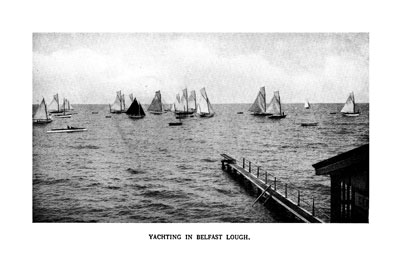
Cricket.
Although Cricket is regarded as a "foreign" game in many parts of Ireland, in Ulster it enjoys a remarkable degree of popularity. As in England the village green has been the nursery of the game, and to Waringstown. a little village near Lurgan, in County Armagh, falls the distinction of having the oldest club in the country. This Club has the most picturesquely situated ground in the Province, the playing pitch being located in the beautiful grounds of Waringstown demesne. Mrs. Waring, widow of the late Major Holt Waring, is the President of the Club, and is also a Member of the Committee of the Northern Cricket Union, the governing, body of the game in Ulster, she being probably the first lady to hold office in connection with the government of the game in the British Isles. In passing it may be mentioned that the Waringstown Club is one of the strongest in the Province, having won the Senior League in 1924, and figured in the final tie of the Senior Cup in the same season. '
There are ten Clubs in the Ulster Senior League, four of these being in Belfast, and the others are in Holywood, Comber, Lisburn, Downpatrick, Armagh, and Waringstown. A strong competition is also in existence for Clubs in the Tyrone and Derry district, where there are several excellent grounds. Most of the League matches in these competitions are arranged for Saturday afternoons and holidays, but there are frequent mid-week one-day matches. Once or twice in the season representative games take place between Ulster provincial teams and sides representing Leinster and Munster respectively, while International matches with Wales and Scotland, and fixtures with English County teams are played in Belfast from time to time.
There are innumerable junior competitions in all parts of Ulster, and every seaside town and inland health resort has a Cricket Club within its borders. Where the visitor is anxious to play, or practice, he will be given every facility by the secretary of the Club in the town or village in which he may be staying, and if there are several devotees of the game in the same hotel or boarding house, it is an easy matter to arrange a game with the local side which can invariably be got together very quickly.
The Ulster Tourist Development Association. acknowledges with gratitude the photographs contained in this Guide, which are the property of Mr. R. J. Welch, Lonsdale Street, Belfast, also, one from Mr. A. R. Hogg.
|
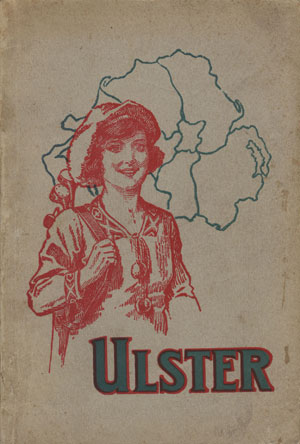
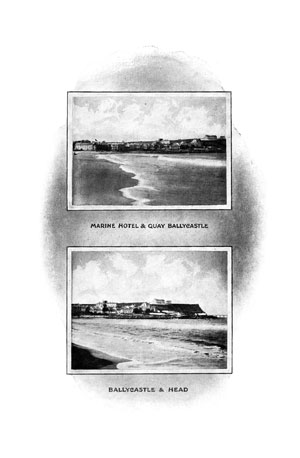
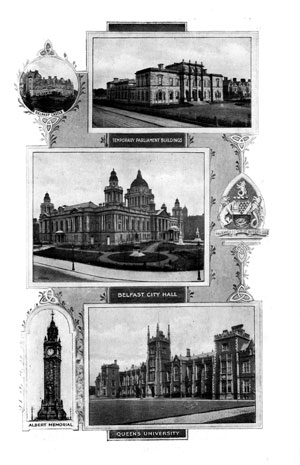
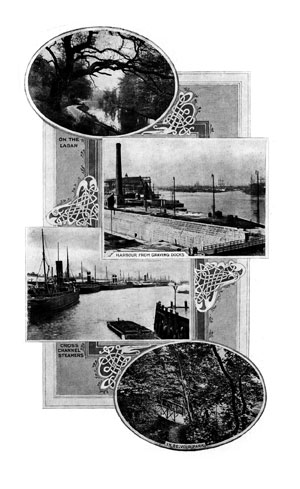
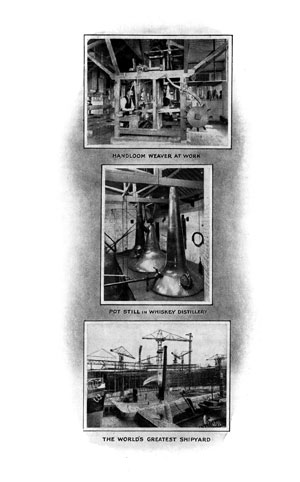
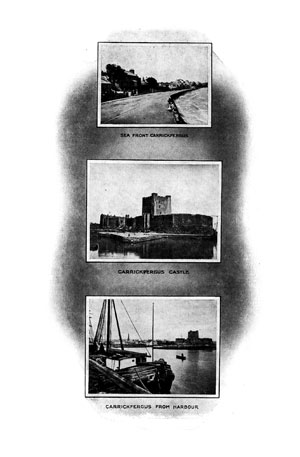
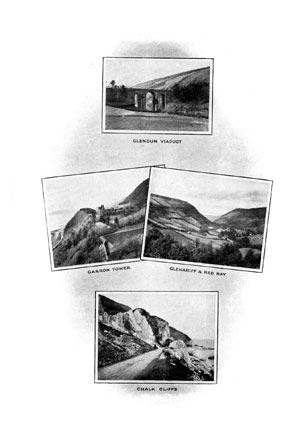
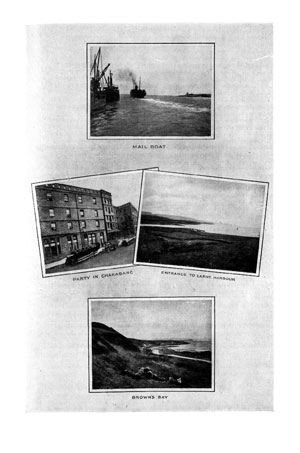
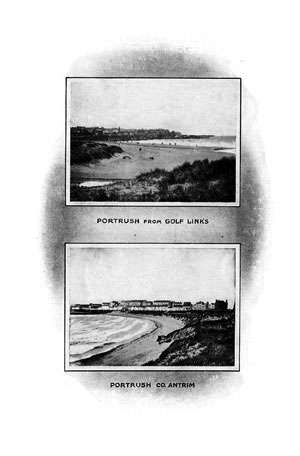
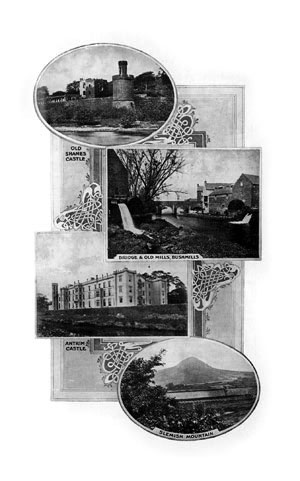
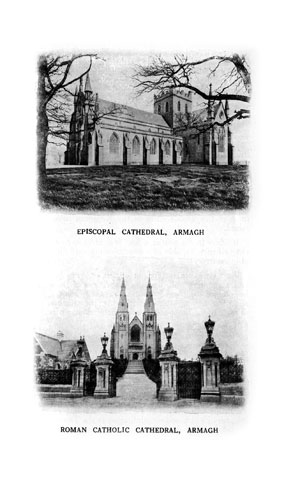
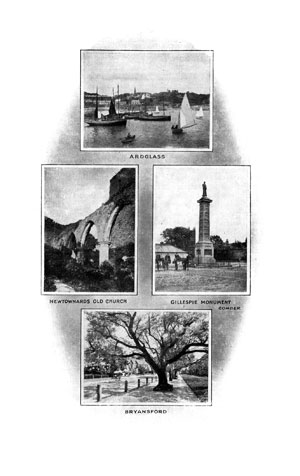
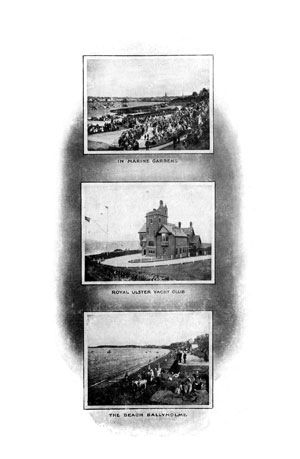
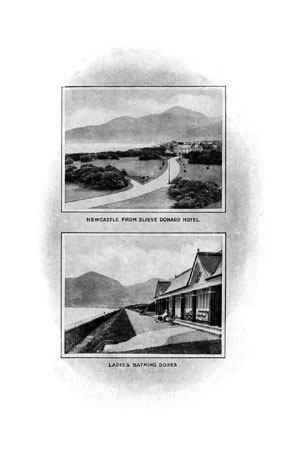
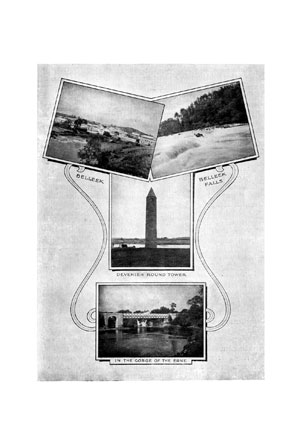
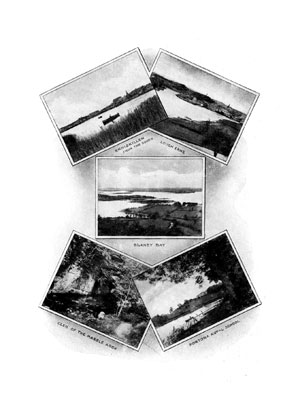
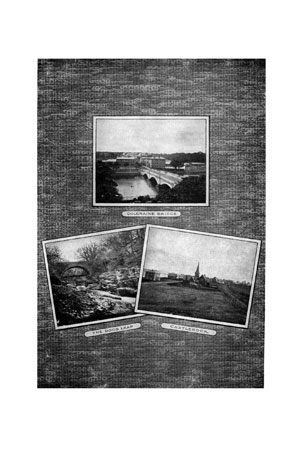
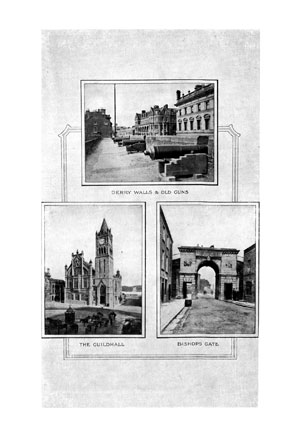
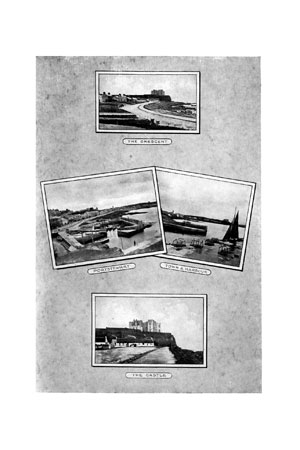
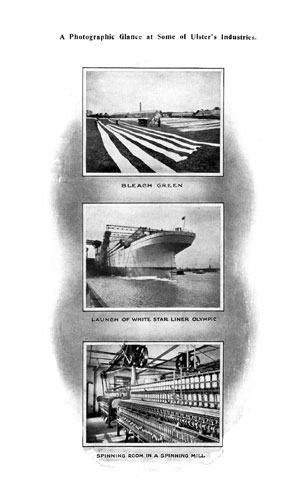
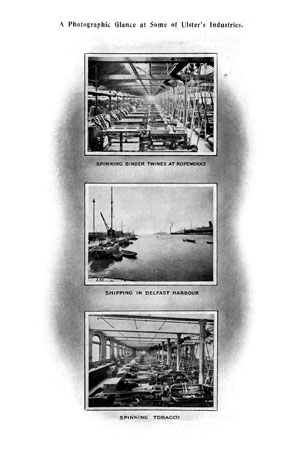
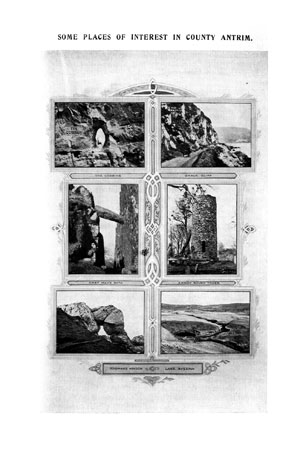
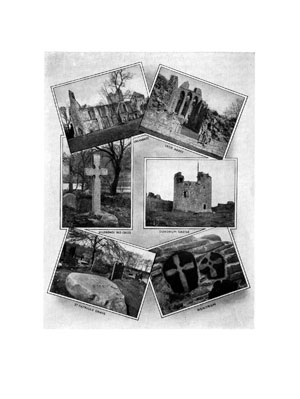
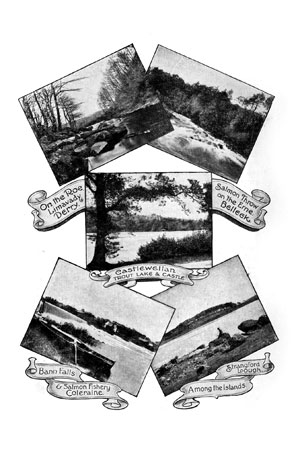
|